When we last gathered in October, we had a delicious time sifting through the early chronology of our obsession, 9402 Pacific. A mysterious presence, 9402 Pacific has, as long as any of us remember, displayed quiet walls—a kind of beautiful, hypnotic effrontery that has appealed to countless sleuthhounds through the decades. More than a shelter to those lucky enough to have called her home, 9402 reflected and informed her dwellers and I declare, gave a few pointers to the inhabitants of the whole West Pacific area. I have relished the correspondence with those of you who have reached out since the posting of this investigation’s first dossier but truth be told, my readership’s queries of 9402 began long before that. (There are only two other properties in town that I have received this much mail about.) It would seem that she is something of a darling and a headscratcher to many. I find it a grotesque exaggeration but some have even painted her as a District 66 Eyesore. I speak for her, which can be dangerous for I am of the belief that these homes have their own personalities and communication, when I say 9402 Pacific’s perspective is to be praised, infinitely to be exalted, for remaining so pert and brave in a forsaken world built up around her. Born in 1904, she is the last of the old farmhouses around these parts. There is something theatrical about it all. So inspired am I by 9402 Pacific’s tenacity, that my hands just now begin to clap and I rise to my feet as I would for a witty actress with a messy chignon daring a damned difficult situation. Brava!
In this second chapter we will again find the fingerprints of 9402 Pacific Street’s owners past, complicated, partially due to the passing of time, mixing of fact with rumor and legend. Plan to change into your gumshoes and creep with us. We will also wander and whisper into the surrounding properties, as we watch West Pacific develop into the West Omaha we see before us now. Then we will unspool it all here on this mound of an office desk by the green illumination of this banker’s lamp, while listening to Edvard Grieg. Please take your time and peruse Mysteries of Omaha: 9402 Pacific Street Part One, if you’d like a brush up or if you are wondering what this current dispatch is all about.
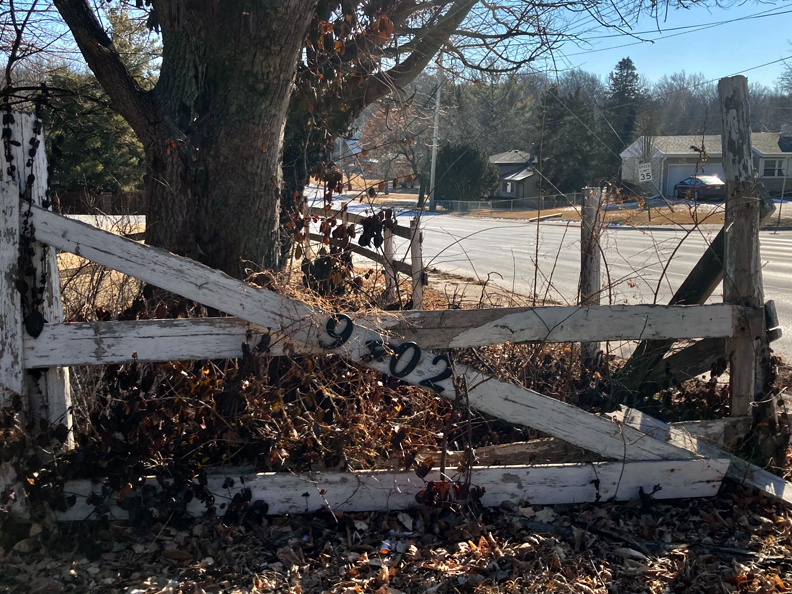
The 9402 Pacific fence on February 28, 2022. Camera facing east.
The Phantom Rancher
Before we move back to the 1920’s where we left off, we’ve got a current matter to consider. We previously speculated on the impending demise of 9402 Pacific Street. I had my proper tour in 2020, but had you guessed, I’ve reexamined her again and again? ‘Tis true, I’ve gone back to survey for clues a handful of times. It appeared that I was not the only visitor. Back in early April of 2022, I was having an impromptu sniff-about and began making a new film. Either rascals, varmints, critters or human squatters, I was struck with the keen awareness I was being viewed from within my dream home. I could feel their beady eyes. There was no vehicle to be found but an open glass door. (It is a melancholy thought that the Break-in Body watching me should know so little about the house apart from the open door and living inside. A very melancholy thought indeed, considering it was my dream home and I had never once thought of breaking in and claiming it for my own. So I turned the dark day to glistening by envisioning that the new inhabitant was equally obsessed with 9402 Pacific as we, the beholders.) I wanted to have a look-see, but was overcome with apprehension. An old memory from my long ago file bank emerged of finding a soiled sleeping bag with piles of opened cat food cans and a browned fork while doing surveillance on a house in Lincoln. These memories singe forth with a balm all their own. As to 9402 Pacific and I, well I beat it out of there quick and have never returned. I feared the squatter/s might accidentally burn the place down in an attempt to stay warm. By the fall of 2022, there was a yellow “DANGER-CLOSED” sign put up by the City of Omaha Planning Department in the south-facing picture window of 9402 Pacific. It read: “Any person who occupies this structure, and any person who defaces or removes this placard, may be prosecuted and punished by a fine up to $500 and/or imprisonment of up to six months.”
Play the short film by clicking on the arrow.
This Just In*
All the while since my recent regrettable absence from the detective office (due to family issues), we have learned from My Omaha Obsession friend, LB, that 9402 Pacific was added to the city demolition schedule; a day later My Omaha Obsession friend, SH, tipped us off that a preliminary plat for Pacific Rows was just approved by the Omaha City Council on January 25, 2023. That is to say that things are moving along quickly in the funeral arrangements of our old gal. I thank you both for keeping us au courant. The 2.0 acres at 9402 Pacific Street are being subdivided into “21 single family residential lots and five outlots as a part of a cluster subdivision.” The below link, if interested, is the December 2022 Planning Board Application for Pacific Rows.
https://planning.cityofomaha.org/images/PDFs/PlanningBoardApp/2022/December/11.pdf
I trust I am in good company and able to convey my philosophy with like-minded or at least open minded folks on this site. We are here to examine, critique and champion the history of 9402 Pacific. There are very real reasons why 9402 Pacific looks as “old” as she does and other explanations why she is being described as a public eyesore crying out for trendy in-fill row house development. At about 119 years old, 9402 Pacific is one of the oldest structures in the area, if not the oldest. She and her string of owners attempted to uphold something rustic, special and altogether distinctly historic to District 66 in an era that has increasingly celebrated stylized, throwaway consumerist futurism. Through our investigation, some of us will come to see her triumphant, curious and unfortunate circumstances.
As They Were
Before we inch one creep further, let us huddle here and consider the cultural changes that Anna Ott and her family experienced at their 93rd to 96th and Pacific Streets farm. The Western Trail was gaining traction in those years and it is this particular subtext that beguiled me. The Charles W. Martin Company and the Byron Reed Company had begun trumpeting a new tune back in 1918 with the advertisement of their Beverly Hills addition (78th to 84th, wedged between Dodge and Pacific): “Feel the thrill of the soil, to plant and harvest, to help yourself, your neighbor, and your country, to build up physical strength and financial independence, to breathe deep of pure country air.” As I mentioned in previous installments, the Happy Hollow Club had moved outside the city limits to 98th and Center in 1925. The lure and prestige of the country club only encouraged more building in the areas out west. The Shuler & Cary real estate developers had also been buying up great West Omaha farmland in the 1920s. They were the super-duo behind the Ridgewood and Loveland additions on West Pacific, at about two hundred acres, leading to further development of Rockbrook out on 105th Street, adjoining the Happy Hollow club. “By 1926, their suburban residential venture grew to include property lying south of Pacific Street from 78th all the way to 96th Street.” As the tide flowed and filled in around 9402 Pacific, Anna Ott surely recognized her acreage could make a profit when she was ready to retire the farm.
Step by step toward the west, from the crest of one hill to another, Omaha’s better residence districts have moved, until one seeking to visualize the urban limits of the future, must look now to cornfields and meadowland miles to the west of the river. This growth has been certain since Capitol hill was succeeded by the West Farnam hill, and that in turn by Dundee and Lockwood and the districts near them, and they in turn by Fairacres ridge. Now a new factor has come into this trend in city growth and the new factor is the securing of country homes for city workers; country homes built upon acre and half acre tracts, giving the man who works in the city, almost rural surroundings when he returns to his home in the evening; and giving his family during the day the pleasures of the open spaces, the quiet, the freedom from traffic peril, of the country.
OWH 1925
Naturally this meant the utility companies were stretching beyond the city limits in accompaniment. In this mid twenties period, the telephone company was reported to install a cable line to 90th and Pacific and had plans to install another from 72nd and Center out to Rockbrook. The substation newly built in 1925 by the Nebraska Power company at 72nd and Pacific would push its lines west to 105th Street and further south to Happy Hollow club and Rockbrook. City water mains were laid to Happy Hollow club with lateral connections to all parts of Ridgewood and Loveland. “Practically all the road in the subdivisions are graveled.”
Detectives, jot a little note that by 1932, Loveland had crept, in all of its loveliness, west on Pacific, nearly to 96th Street. (Some early records show it encapsulated 96th.) A Comprehensive Program for Historic Preservation in Omaha, compiled by the Landmarks Heritage Preservation Commission, made the point that “some Omaha residents did not wait for the land to be subdivided.”
My Omaha Obsession friend, Joan Field, shared in the website’s early days, that her maternal grandfather was Daniel Greene Cary of aforementioned Shuler & Cary. “To encourage people to build west, I believe in the late 1920’s, with partner Irenaeus Shuler, he also helped develop in Loveland and West Pacific Hills. Shuler built a palatial home facing Happy Hollow Club on, I believe, 105th. My grandfather went on his own and later built a home at 600 South 93rd St in 1939.” That meant by the time Anna Ott was readying to sell her 9402 Pacific farm altogether, the Daniel Cary home had been erected, one of the only neighbors of the nearby subdivision. The Cary home was within shouting distance of the Ott farm. And what would one shout, pray tell?
“What’s the word, Dicky-bird?!”
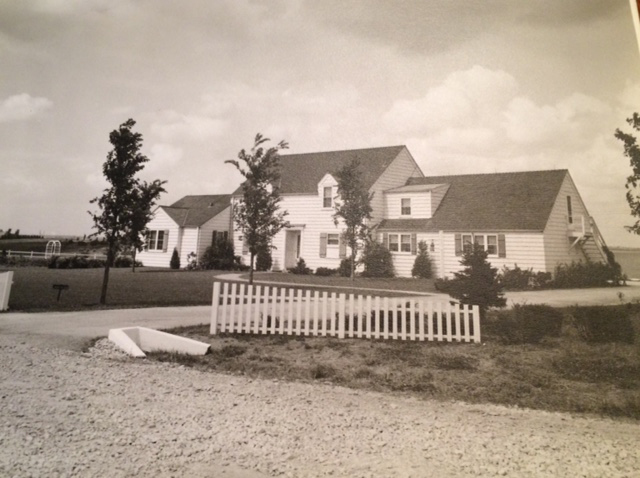
The Daniel Cary home at 600 South 93rd St, built in 1939. Photograph from the Joan Field collection. We will see this home again in the near future.
The West Pacific Tribunal
When we last crossed paths in July of 1937, Anna Ott, then a widow, (husband John Ott had died in April of 1927) had sold “five acres more or less,” of the family farm–essentially the western edge of her farm. This was the 96th and Pacific corner–the Hidden House property that we had formerly immersed ourselves in. Interestingly Anna restricted these five acres “for residential purposes only.” The well to do Reichstadts took up ownership and built a fine estate shortly after.
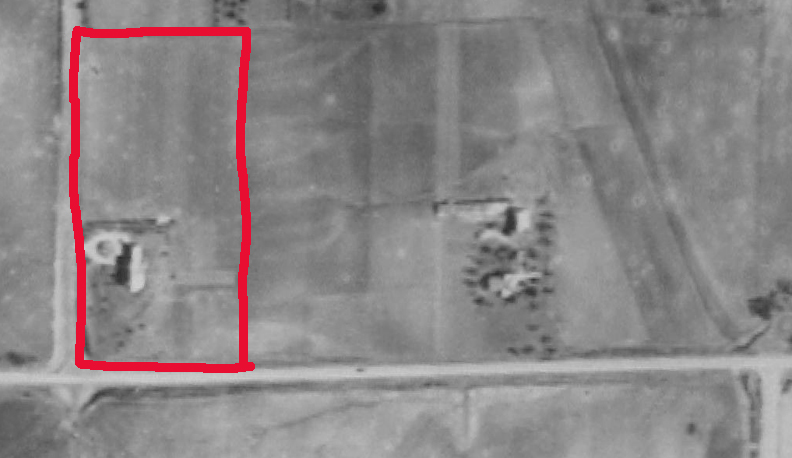
1938 aerial of the Ott farm, subdivided. The Reichstadt estate “Hidden House” on the northeast corner of 96th and Pacific. I outlined in red to show this newly divided five acres. The Ott home to the east, at 94th and Pacific. Image borrowed from the DOGIS website.
It is my personal ambition to time travel back to 1942 and stand on the eastern most edge of the Reichstadt property. I should like to goggle across to the Ott farm and even up the hill to the old Melady estate. Can you imagine that view?
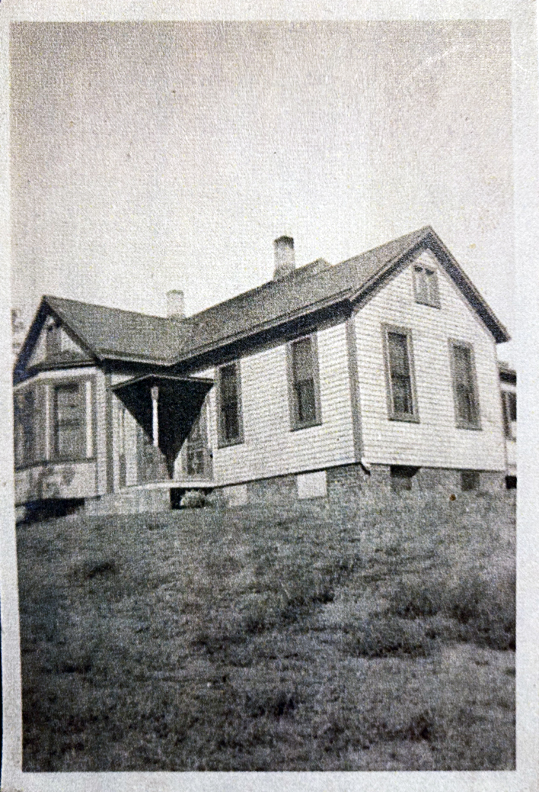
Historic 9402 Pacific Street photograph borrowed from Woodie Arp’s family collection.
We now know that Anna and her adult children were living down the hill in the 9402 Pacific Street house. From the deed I would discover that Anna sold that house and the east ten acres of the property to Roger P. and Helen L. Holman in August of 1941 for $8,400. But there is evidence that the Otts had moved on earlier. According to the United States Census of 1940, Anna Ott, then 74 years old, continued to live with her children in son Henry Balster’s house. He was age 46 and unmarried. Also sharing quarters were brother Fritz, (45), half brother Rudolph (37), Rudolph’s wife, Frances Ott (32) and their son, Rudolph Ott, Jr., called “Jack” (10).
At the time of her death in 1945, Anna Ott was 78 and living at son Henry’s 5834 Hickory Street, a Minimal Traditional frame house in the exceptional Aksarben-Elmwood Park Neighborhood. From there the Balster-Ott siblings would move again to 5815 Pacific Street in April of 1954.
If I am tracking acres correctly, and counting acres or much of anything a step from vintage beaded cardigans and rhinestone hair combs is not my strong suit, that left about five mislaid acres of the 20-acre Ott farm. Disappeared. Unaccounted for. You get this detective language. My early suspicions, dependent on the boundary lines of the newly partitioned 10-acre Holman farm, were that what is now the Sunset Hills Baptist Church and the current homes to the north of said church comprised the missing five acres. In Part One of this investigation I introduced Woodie Arp, relative of Anna Ott. Woodie would provide much needed documentation about this additional five acres, of which I am overjoyed to share.
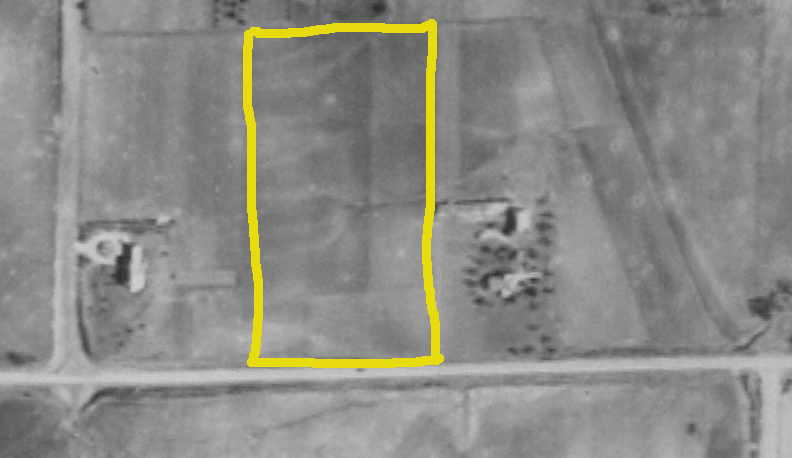
1938 aerial of the Ott farm, subdivided. I outlined the perimeter in yellow– my suspicions of the missing five acres. Site of the Sunset Hills church property. The Ott home to the east, at 94th and Pacific. Image borrowed from the DOGIS website.
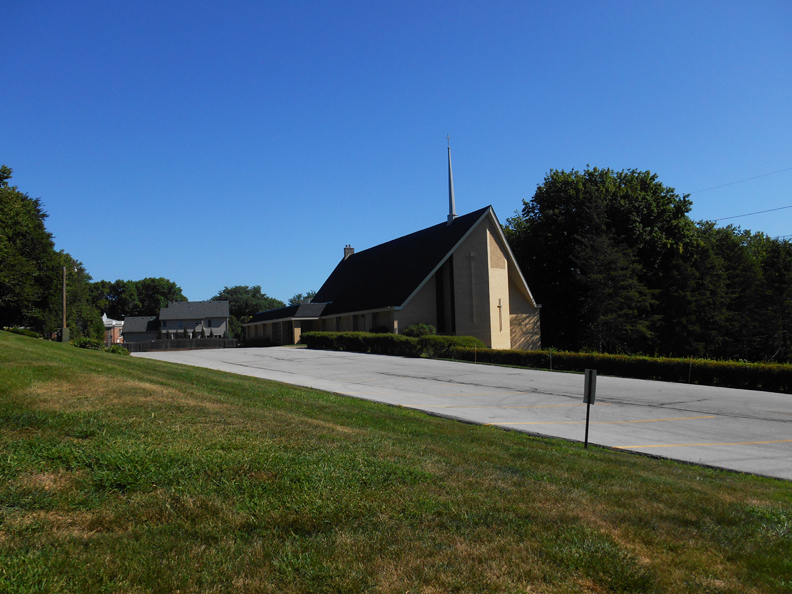
Sunset Hills Baptist Church at 9416 Pacific Street. Homes to the north. Camera at a slight northeast angle from Pacific Street. Photo taken in August 14, 2020.

Just a smidge view of the beautiful grounds and rows of trees found on the Sunset Hills property. This abuts our 9402 Pacific obsession. Camera facing northeast. Photo taken in August 14, 2020.
But let’s get the Holman family moved into 9402 Pacific first.
Omaha Confidential
Returning to our purported narrative, in teeny tiny print the World-Herald announced Anna Ott sold the farm “R. P. Holman & wf.”

OWH. Aug 7, 1941.
Warranty Deed from the Douglas County Deeds Office revealed Anna Ott sold the ten-acre farm for $8,400 to Roger P. Holman and Helen L. Holman, husband and wife, on August 5th, 1941.
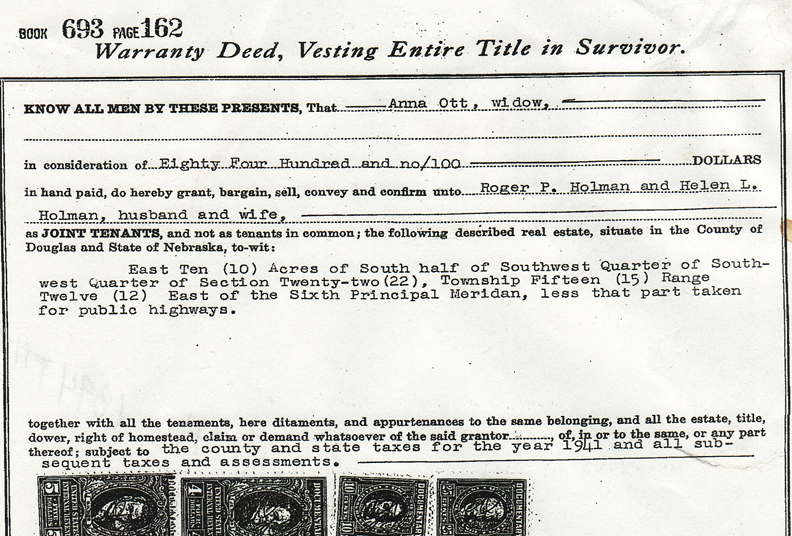
I found the conveniently well-placed Ott farm front and center of a “Trend Toward the Pastoral,” as the World-Herald called it in 1942, when more and more moneyed families began to refocus their interests “around the home, with an emphasis on the land and what it produces.” Let’s knit one, purl one on this point, as the Holmans’ assessment and determination to buy the Ott’s farmhouse is particularly trendsetting–a decision that would champion 9402 Pacific as a cool, exclusive, lasting property for decades while hundreds of acres of farmland were converted to low-density residential subdivisions all around her midst.

General Tire advertisement from 1943. Rural life was seen as frugal, responsible living and downright patriotic.
As a reaction to World War II and America’s impending involvement, residential as well as holiday interests fluctuated in a return to simple, functional, bucolic beauty. Elm trees, assorted fruit bearing trees, horse pastures, a garden, a lily pond, chicken house, combined barn and gardener’s outbuilding, complete with sheep, a goat and a cow. Suburban homes, just outside of town, “stepped up farm production or first time ventures in chicken raising or gardening.” Both garden output as well as the tremendous quantities of eggs, duck, chicken and beef were boasted about as only city-folk can do, within the Society Page, lest you forget. The photos divulged well to do families herding their cattle, coddling their chickens, silver spoon children riding in a basket cart led by a pony at a summer getaway on a friends’ farm, along with vacation play at an upper crust weekend ranch. The city-bred were reconsidering life on the range. It is this deep-pocketed country living that interested me, both as rural folly and for the upbuild (outstretch) of Omaha, as these old farms refashioned into tracts of modern housing.
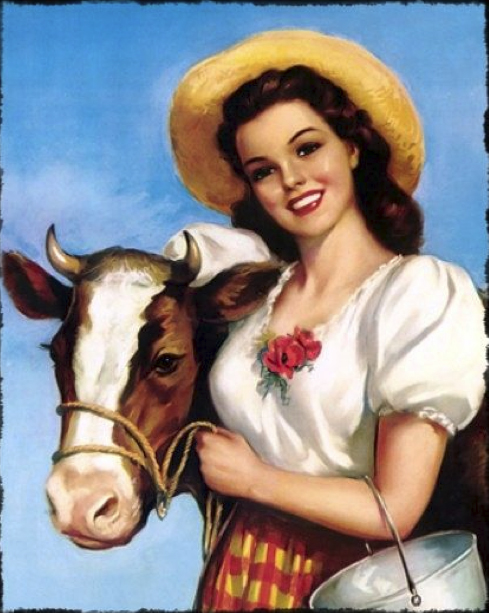
The Dairy Queen as dream girl.
My past efforts to chronicle the rise of suburban Omaha, particularly along Pacific Street, is perhaps a drudging one to some, but I find it altogether engrossing—so we will continue to trowel away to our hearts’ content. (I say hearts plural because I know you feel the same as I.) I only shine the flashlight on this ironic burgeoning farm trend because this 1920s to early 1960s window exhibited a rare integration along west Pacific Street—the last of the authentic agriculturists coinciding with the nostalgic Johnny-Come-Lately suburban dwellers. In these societal matters, again, no official explanation is offered to this detective’s satisfaction except occasional hints. The amplitude of migration stories link to the motives we have considered in the past in no particular order: the reaction to the purported filth of old downtown Omaha; the rising population of eastern Omaha; escape from in-city taxes; the war and approaching national scarcity of goods; moneyed Omahans becoming enchanted with the relocation of the Happy Hollow Club; white flight as outlined in Lois Mark Stalvey’s The Education of a WASP; draw of the lower land values out in the country, (soon to be called suburban areas), offered larger building sites for the spread-out MCM ranches; impression of dangerous urban streets; the GI Bill gave veterans access to low-interest housing loans and folks wanted their own, brand new home; the perceived social advancement to expanding West in Omaha.
As a side note, we have witnessed the pandemic inspire home gardening and a growing national houseplant obsession as city dwellers and investors continue to buy up rural land outside of metropolitan areas. The “recreational ag land” and what is called “lifestyle farming” on smaller acreages is almost a mirror of what happened in the 1920s-1940s Omaha.
The Butter-Nut Connection
Born in 1883 in Paragould, Arkansas, Roger Pressley Holman first crossed My Omaha Obsessions’ formal radar in the 1910 U. S. Census where I discovered the then 26-year-old Holman was living as a single man, rooming at the Harney Street YMCA with 26 other male residents of ranging ages. Omaha’s downtown YMCA offered affordable accommodations amidst declared hotel-like dormitories including access to a gym. Our man Holman was logged as working full-time as an auditor with the “Whole Grocery,” later to be discovered as the Paxton & Gallagher Wholesale Grocery firm. William Paxton and Ben Gallagher organized their Paxton and Gallagher Wholesale Grocery in downtown Omaha around 1879.

The new building of the Paxton & Gallagher Company at 711 South 10th Street in Omaha, Nebraska. A line of freight cars sit beside the warehouse. Creator: Bostwick, Louis (1868-1943) and Frohardt, Homer (1885-1972). Publisher: The Durham Museum. Date: 1911. Note the KAMO brand mural painted on the Paxton & Gallagher building mentioned below.
Reputedly while employed as a cashier for Paxton & Gallagher, young Holman “sold the management on the idea of putting up coffee in tins and marketing the first ‘advertised’ coffee in the nation.” Only three years after his YMCA lodging, Roger Holman additionally created the now legendary name, Butter-Nut, into a highly marketable brand for the local company. “Morris B. Ogle, a retired green-coffee broker and tester, told World Herald columnist Robert McMorris in 1984 that the name was the idea of Roger Holman, a cashier for Paxton & Gallagher. Holman got the idea from his home state of Tennessee, where butternut trees flourish. Paxton & Gallagher at the time put out two brands of coffee– Kamo, which meant ‘came from Omaha,’ and P & G, which was the top brand,” Ogle said. Butter-Nut coffee became widely available in the Midwest.
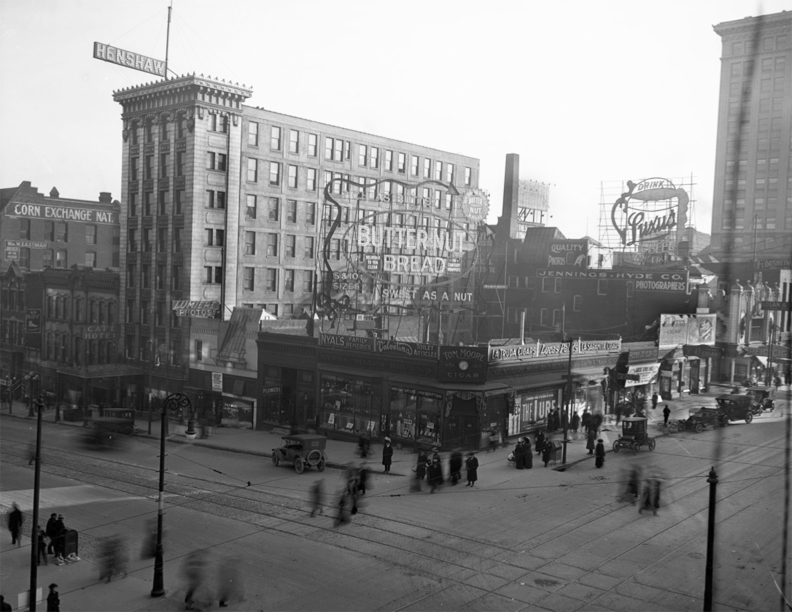
Looking Southeast at 16th and Farnam Streets, Omaha, Nebraska. Parked cars line the street, people walk along the sidewalks. Notable buildings include: Myers-Dillon Drug Company, Butternut Bread Sign, Henshaw Hotel. Creator: Bostwick, Louis (1868-1943) and Frohardt, Homer (1885-1972). Publisher: The Durham Museum. Date: December of 1913. In 1913, Paxton & Gallagher introduced their new brand, Butter-Nut with the slogan “a coffee as sweet as a nut.” Within the year, they had developed their Butter-Nut Bread, evidently, according to the large lit sign above this store at 16th and Farnam, was also sweet as a nut.
“Down home Tennessee,” was perhaps generated in the roasting haze and lost to lore, as our man Roger Holman professedly hailed from Arkansas in accordance with his self report and the family genealogy. Did “butternut trees grow like ragweed” in Arkansas? Yet, aside from that little is known of his earlier role in the grocery business other than working as a cashier/auditor and gaining the ear of the big boss. Holman was credited with naming Butter-Nut Coffee and for coming up with those blessed coffee tins. Charles Pickens, then Paxton & Gallagher’s president, liked the idea, the catchy name and obviously young Roger Holman, as I would find Holman rose up through the firm’s ranks in the decades to follow. It is known that years after Butter-Nut’s creation, our man Holman would continue to play a leading role in his brand’s success until his death. However by 2022, the ButterNut Foods’ website sadly neglected to boast of Mr. Holman, while describing their roast of 1913. What was the truth?
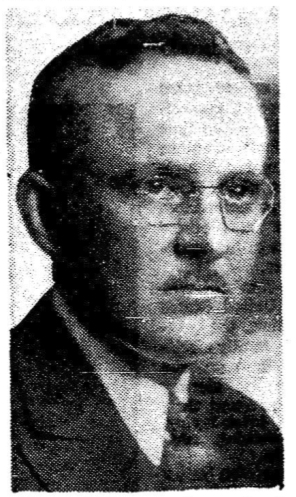
The impressive Roger Pressley Holman, Butter-Nut executive.
In another telling of the tale, this version from the World-Herald in 1945 and perhaps more compelling because of the timeframe, it was Paxton & Gallagher employee, Fred Turner, a coffee specialty salesman who sold “Turner’s Special” coffee in bulk, who had the notion to sell the same blend in cans, under another brand name. In this version he chose “Beech-Nut” but because this name was already registered, Paxton & Gallagher adjusted it to “Butter-Nut.” Roger Holman worked “behind a cage as cashier” and was said to then persuade president Charles Pickens that a singular advertising campaign featuring only Butter-Nut in a can would be a winner. From this Holman became the “genius of the Paxton & Gallagher selling end” but had nothing to do with the naming of the coffee.
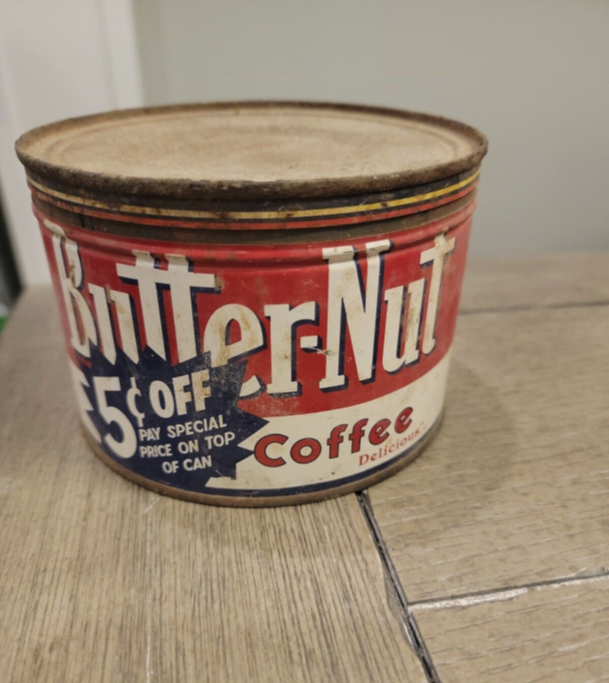
Early Butter-Nut tin photograph (1920s-1930) borrowed from Ebay seller. We can be sure the Holmans’ 9402 Pacific’s pantry was stocked to the hilt with these cans of Butter-Nut.
Side Note to the Curious
Do you mind pausing for a moment? Huddle in. We must discuss the methodology in surveying 9402 Pacific’s humans. It occurs to me that I have gone in depth to the point of being exhaustive with some of the following homeowners and other holders will be seemingly tiptoed through. These disparities are due purely to my neurotic whims, time constraints or that I wasn’t able to locate much in the Omaha annals. We have paused long enough and must get back to the case but some of you may continue to hover and discuss in this warming hut over hot buttered rum.
The Holmans from Omaha
Roger Holman married Illinoisan girl, Helen Irene Lindsey, in February of 1916. They had a son named David and daughter Sally (Sarah elsewhere) Holman.
**Addendum of February 22, 2023** Lindsey Hughes, daughter of Sally Holman, granddaughter of Roger and Helen Lindsey Holman, shared that her mother’s name was indeed Sara (without the “h”) but that she went by Sally.
In 1916 Roger Holman lived at 5007 Cuming Street, potentially as a single man, previous to their marriage. 5106 Burt Street was home in 1919 and 1920. By 1921 the couple lived at 119 South 51 Street. The 1930 U.S. Census showed the family resided at 541 South 52nd , in addition to Hattie Reynolds, widowed mother in law, and live-in family maid, Jane Kavanagh. From the Omaha City Directories housed down at the W. Dale Clark Library (RIP), I would learn that the Holmans lived at this 541 South 52nd Street address until they moved out to West Pacific. Of note all of these houses are within close proximity to one another, obvious blocks, observably Dundee proper. All of these lovely homes are a studied reflection of the Holmans’ status, as Roger Holman climbed to sales manager for Butter-Nut coffee of Paxton & Gallagher Co. Although this is turning out to be a rather long investigation, I should love to show you each and every one of their early residences. Please click on each image for a better look-see. Divine.
- 5007 Cuming Street. Photo borrowed from the Douglas County Assessor’s site.
- 5106 Burt Street. Photo borrowed from the Douglas County Assessor’s site.
- 119 South 51 Street. Photo borrowed from the Douglas County Assessor’s site.
- 541 South 52nd Street. Photo borrowed from the Redfin site. The house that Mr. Cassette and I named the Mary Poppins’ house long ago on one of our walks. Back in those days there was a large dog or two who had torn up the lawn. It was all dirt. There was a privacy fence that was not doing a very good job of keeping my hungry eyes from staring. Oh Mary Poppins’ house, I LOVE you!
As the story goes, the Holmans were somehow convinced to balk status quo and acquire our 9402 Pacific obsession, forging a new relationship with the country. Now mind you, Holman was openly called “the Father” of the Butter-Nut coffee division, heading up their sales and advertising departments at this time. It is important, in particular, to meditate on the classic European architecture of my favorite Mary Poppins house, as we call it in these parts. Well, no one but Mr. Cassette and I call it that. It is situated on the corner of glamour and practicality. The air is better ‘round there at 541 South 52nd Street. Imagine a well to do family once concerned with their social station, turning their back on all the markers of prestige to ramble off to the country and collect eggs. It is all true.
In digging for clues as to the Holmans’ specific migration to the West Pacific area, I discovered the couple compassed the same social circle as the Daniel Carys (previously mentioned architect and nearby neighbors at at 93rd and Pacific), the Albert and Edwin Busch families (houses at 90th and 96th Street), the Dana Burgess Van Dusens (local attorney owner of the yummy 708 North Happy Hollow Boulevard residence and and getaways around town). I only name drop because these figures will come up again shortly. The Holmans hosted 90 guests at the dinner-dance at the Happy Hollow Club in 1929, alongside these friends, some of whom would also remove to country living, giving further credence that the Holman couple was very well aware of the mystique to the West Pacific area. These signifiers also let on that no one’s hands would get too, too dirty. These were the gentlemen farmers.
The Holman Files
At 59 years of age, Roger Pressley Holman filled out his WWII draft registration card in 1942. Curiously, he listed his residence at 9410 Pacific. Was this one of our mysterious shifting postal addresses or just a mistake on his part? Alas I could not sift further clues after bearing down on this 9410 address lead; I believe it was made in error.
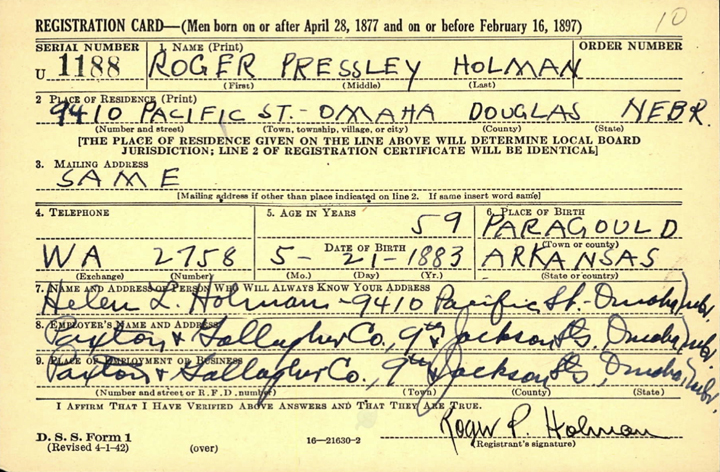

Omaha City Directory 1945. “94th and Pacific.”
For Mrs. Holman there had always been bridge club gatherings and luncheons at the Blackstone Hotel, these weekly mentions in the Social Affairs columns; she and the children would “take a cottage at the beach” near San Diego and spend their summers in California garnering more press. But it was Mrs. Holman’s coverage in the “Omaha Society Section,” for helping to conquer the wartime food problem in 1943, at least within her family, that peaked my interest. I acknowledge that every little bit helped and I credit the plucky Holman brood for doing their part. It was (and remains) important to contribute. I only shine the flashlight on this ironic burgeoning farm trend because this slim late 1930s-early 1960s window exhibited a rare integration along west Pacific Street—the last of the authentic agriculturists coinciding with the nostalgic Johnny-Come-Lately suburban dwellers. As I would discover, it would all change in a few short years. In the meantime the affluent would garner great press for their unusual barnyard endeavors and it is not my intention to snub their achievements, although fascinating from a distance.
Mrs. Roger P. Holman chronicled her 75 laying hens, two hundred chicks and an extensive vegetable garden, measuring 50 feet wide by 150 feet long, “not counting potatoes and sweet corn.” Mrs. was even planning a second large garden on her grounds. Apparently the family moved out to the 94th and Pacific area “as a war service measure” even though Mrs. Holman had never embarked in this type of gritty work before. **Addendum of February 22, 2023** Lindsey Hughes, daughter of Sally Holman, granddaughter of Roger and Helen Lindsey Holman, illuminated that Helen was raised in/near Sidney, Illinois and “knew a fair amount about chickens from a very early age.”
“The farmlike atmosphere of the Holman country residence has been enhanced since Christmas by the addition of a saddle horse, ‘Mimi,’” a gift to the Holman’s daughter, Sally. The article also illustrated the exploits of other gentlemen farmers: “Not far away at the E. J. Busch home not only has production been stepped up but storage facility increased. Fifteen ducks now waddle amid the Busches’ flock of white chickens and the garden output is tremendous.” The Dana Van Dusens were shown with their horses, as were the Louis Metzes and the David Crofoot farm—all well to do families with a new knack for roughing it.
There were also hints that the Holmans’ theme of social gatherings after moving to 9402 Pacific coincided with and signaled the modest times and environ. They became hosts to small group outdoor picnic suppers at their acreage.
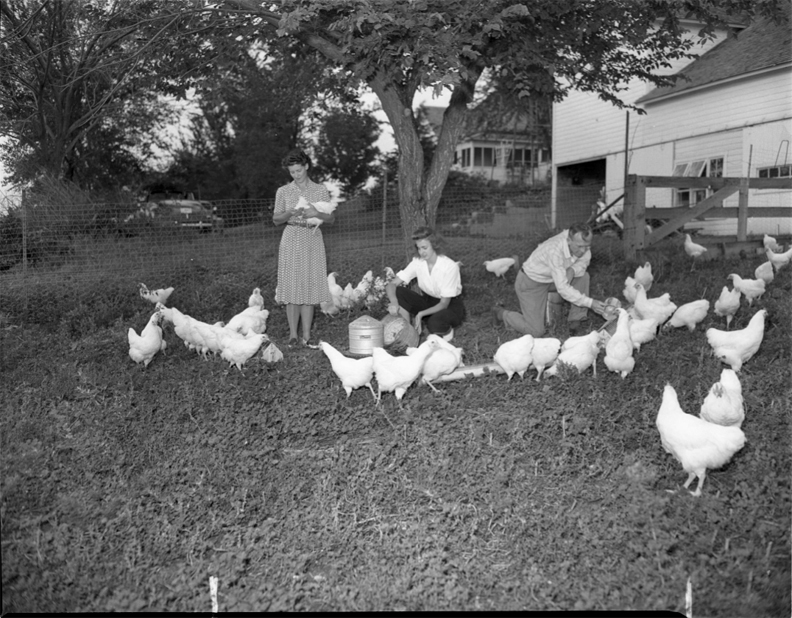
I found the article and photo in the World-Herald and include that text here. But this fetching black and white was found on the Durham site, much better than the OWH print. “Breakfast time for the Holmans’ White Rock pullets finds both Mr. and Mrs. Roger Holman and their daughter, Miss Sally Holman, center, keenly interested.” August 1942. OWH archives. Original photo: Creator: Savage, John (1903-1989). Publisher: The Durham Museum. Date: August of 1942.

Architectural Sleuthing—Let’s look at this magnified detail of the above 1942 image and compare it to my 2020 photos. The 1942 photographer was positioned in the eastern part of the property—now owned by OPPD. But on the 1942 grounds this post up would have been at a northeast angle, facing southwest toward the barn and the corner of the house. It is so great to see what the barn had looked like. Delightful to see the north side of the farmhouse in the distance.

The same angle toward the southeast corner of the barn, converted to garage and guesthouse. The once ground-level horse stalls became four garage bays with an addition on top for guest housing. The main house in the distance, hidden by trees. As seen on April 4, 2022.

The northeast side of the main house. Not the exact angle as the 1942 photo. Reconstruction is evident.
In their second year on the farm, the World-Herald popped by the Holmans’ property again to see how things were progressing.
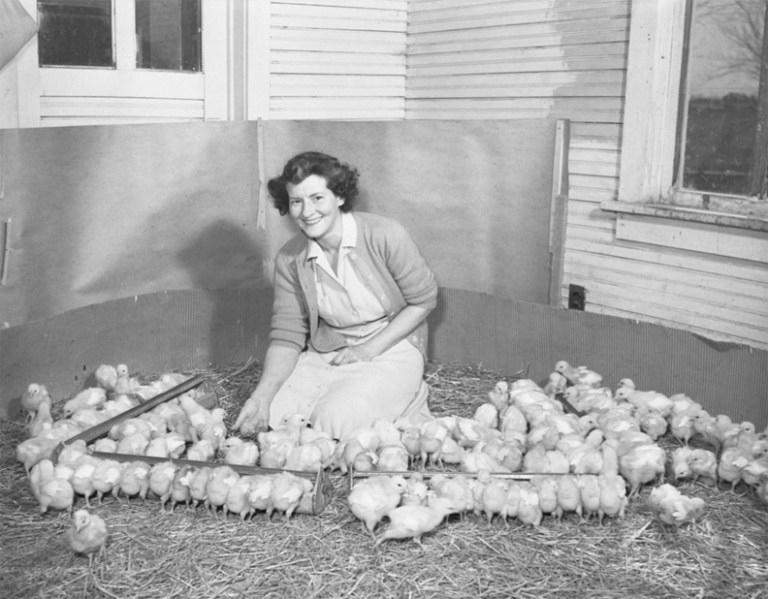
Helen Holman, wife of Roger P. Holman, knelt with numerous chicks at the 9402 Pacific farm. I felt so fortunate to find this one. Creator: Savage, John (1903-1989). Publisher: The Durham Museum. Date: 1943. I found the original image from the World-Herald article on the Durham site.
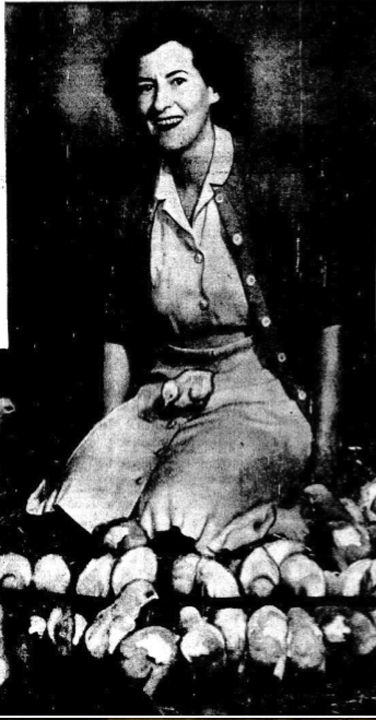
Helen Holman, as she appeared in the original OWH article of April 25, 1943. I love this image and it tells quite a different story than the photo above.
“Mrs. Holman who had never done any such work before, took the responsibility of caring for two hundred baby chicks and lost 150 of them because of improper temperature regulation. Undaunted she obtained a second batch of two hundred, successfully raised 180 of them. This year’s group of two hundred, she said, ‘is coming along find’ in an electric brooder purchased when the Holmans took to the country. Mrs. Holman uses many of the eggs laid by her hens, sells the rest among her neighbors. The vegetable gardens are approximately 50 feet wide by 150 feet long, not counting potatoes and sweet corn. Mrs. Holman plans to raise enough potatoes to last her family through the year, and will fresh-freeze many other vegetables in the freezer located in the Holman home. Chicks successfully raised and not used for egg laying or for eating will also be frozen.” Please tuck away this mention of a freezer located in the Holman house as of 1943.
Daughter Sally was born in 1926 and appeared to have the world on a string. Not only was she beautiful, Sally was an avid equestrienne and natural athlete, and grew up riding in Ak-Sar-Ben horse shows. The 9402 Pacific property allowed for Sally to keep horse, “Mimi,” in the barn on site. Sally was a lifelong sports enthusiast, active in golf, swimming, ice-skating and tennis. She was also creative and focused in the field of art. (More about her artistic influence on her mother later.) Her parents’ contributions to Omaha were recognized when Sally later became an Ak-Sar-Ben princess in 1948. While living at 9402 Pacific, Miss Sally attended Central High School. I know I would have been late to school every day with a haul like that early in the AM.
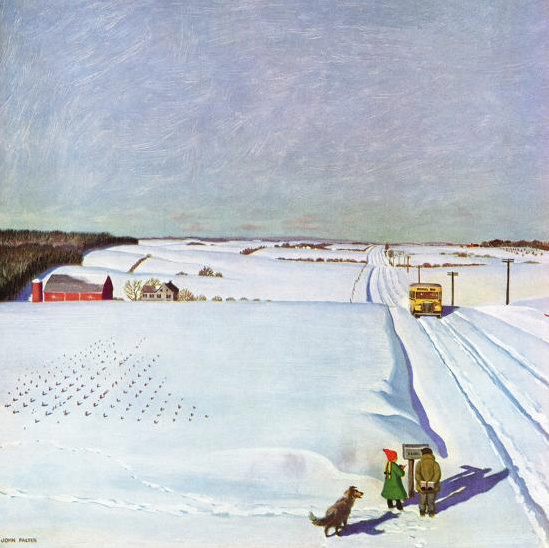
This reminds me of a John Falter painting: “Waiting for School Bus in Snow,” from February 1, 1947. I recognize that Miss Sally probably didn’t have a school bus to come out to the far reaches of civilization but I imagine that rural Pacific looked much like this in the winter.
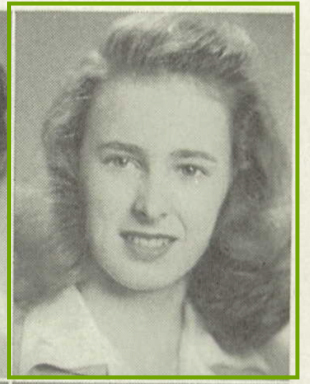
Photograph of Sally Ellen Holman from the 1943 Central High Yearbook.
A graduate of Monticello Junior College in Alton, Illinois, Miss Holman then took employment as a member of the Joslyn Memorial Art Museum staff for a year. When interviewed as an Ak-Sar-Ben princess, it was noted “she has traveled extensively in the US and her plans for the future include travel and more work in the field of art.” Sally moved to Idaho in 1951 and married Boyd Harris in fall of 1953. With Boyd she had children Jeff and Lindsey and lived in Caldwell, Idaho.
There were a few clues to suss out. I am of the belief that no large additions were made to the original Ott farmhouse in the early Holman years. In accordance with the frequent advertisements Mrs. Roger Holman ran over the years for domestic help– “woman for light housework,” “housekeepers for the family home” and a “middle aged handy man to stay on place,” Holman’s ads tipped there were only a “family of three” living in the “small house” at 94th and Pacific. I could see from the previous photo and clues that Miss Sally resided in the home with her folks. This mention of only three Holman family members also got me wondering–where was the son?
The Away Son
Son David was born around 1923 and had grown up with little Sally, Joan and Junior Busch—their family friends mentioned earlier. David attended Brownell Hall for kindergarten. The Holmans received their society nod when David was selected as a page in the Ak-Sar-Ben Coronation Ball of 1932.
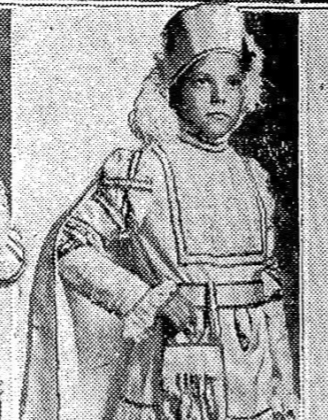
Page David Holman as seen in the OWH in the fall of 1932.
I would trace Junior Holman to the prestigious Lake Forest Academy boarding school on the North Shore of Lake Forest, Illinois and soon after, Wentworth Military Academy in Lexington, Missouri. This military academy and college was a high school and two- year “military junior college” founded in 1880 and is now closed.
By 1943 David Holman had joined the Army Air Forces; in 1944 he was training with the air transport command at Miami, Florida and the following year was a private with the Air Transport Command (ATC) in India, flying in a transport unit between Calcutta and China. When David was discharged and honored with an air medal (awarded for single acts of heroism and meritorious achievement while participating in aerial flight) from the India China Division of the Air Transport Command, I had to dig in further to understand. This India-China Division was tasked with air transport of supplies, personnel, equipment and aircraft to China over the Himalayan Mountains, called “The Hump;” interestingly, they were “not subject to control by theater commanders,” instead answering to their own wing commanders. In 1944 the India-China Wing, ATC (ICWATC) became the first non-combat organization to be awarded the Presidential Unit Citation for flying “The Hump.” From the Air Mobility Command Museum site within a history by Jack Kinyon, ATC, 1942-1947, Air Transport Command – Airlift During WWII: “The India-China airlift was dangerous because there were no radio navigation aids, maps were unreliable, and the weather was unpredictable. Daily operations for 42 months resulted in delivery of 650,000 tons of materiel. Most of the personnel were from ATC with support from Britain, India, Burma, and China. Thirty-four thousand military personnel and 640 aircraft were involved. Five hundred forty-nine aircraft (86%) were lost or destroyed, and 1,659 personnel (5%) were killed or missing.” The India-China Division was inactivated in 1946.
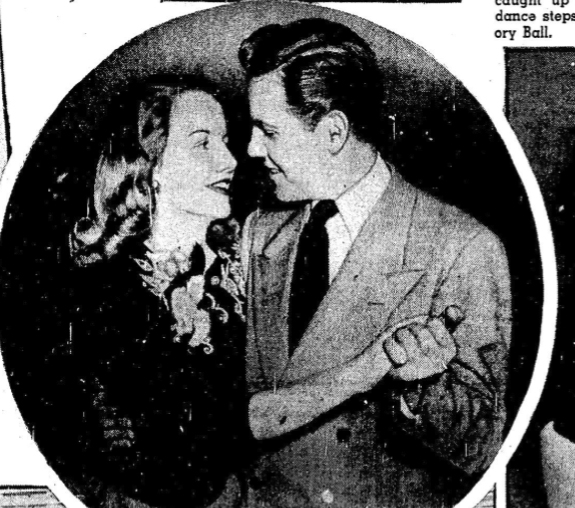
OWH. Dec 30, 1945: “Miss Adele Hackett and David Holman caught up on the latest dance steps at the Memory Ball.” The Blackstone Hotel hosted two parties–dances for returning World War II veterans: Omaha’s first Memory Ball and a Homecoming Ball. I would track David in the next few years—there was much running around, socializing, sporting and travel. By February of 1947 he had registered as a freshman at Grinnell College in Iowa for the second semester, a challenge for any service member who had already seen the world, let alone World War II. David moved to Albuquerque, NM in January of 1948, after getting collared on a number of speeding tickets in Omaha—the judge noted that those who flew in the service had a hard time minding the civilian speed limits. But I would argue that that was when cars were really hitting their stride. What young fella wouldn’t want to tear around town in those late forties automobiles? David would marry and have daughter, the family living in La Junta, Colorado in early 1951. Son Roger was born by 1952. The family moved to Colorado Springs and later Denver.
Let us retreat back to the period when David was discharged from service—it was the Thanksgiving of 1945 son David returned home for the holiday to spend time with mother Helen and sister Sally, also visiting from Monticello College in Alton, Illinois. That was when I was surprised to learn that father Roger had died back in March.
Death of Roger Holman
Mr. Holman died on March 3, 1945 while in San Diego, after an illness since November. Because of the Holman family’s aforementioned frequent holidays to San Diego, I wonder if Roger had gone there for medical respite in the warmer climate? At only 62 years of age, Holman was the “Father” of their Butternut Coffee division of Paxton & Gallagher. He was buried March 8, 1945 at Forest Lawn Memorial Park.
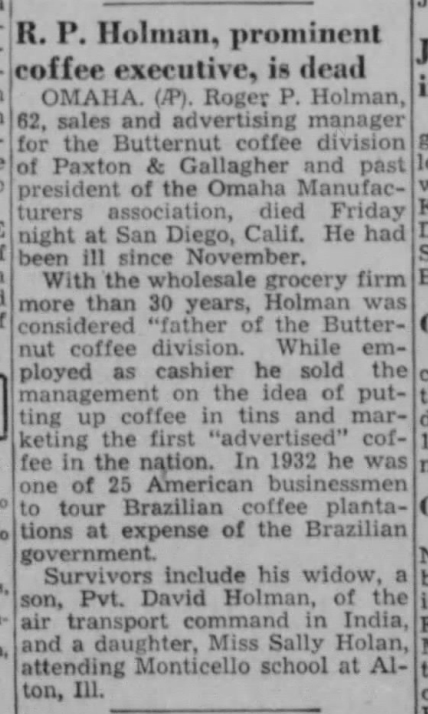
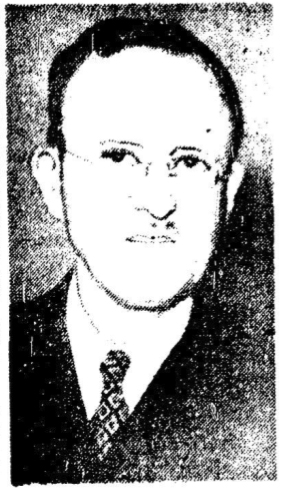
Obituary from Lincoln Star. March 4, 1945. Older photo of Roger Holman from the Omaha World Herald.
The Missing Five Acres
I’ve got to believe the Helen Holman and children continued on with brave faces in spite of the death of Roger. We will check in on them in a few moments but first…in this 1946 time period, our friend Woodie Arp, relative of the Ott family would discover some important paperwork in the family archives.
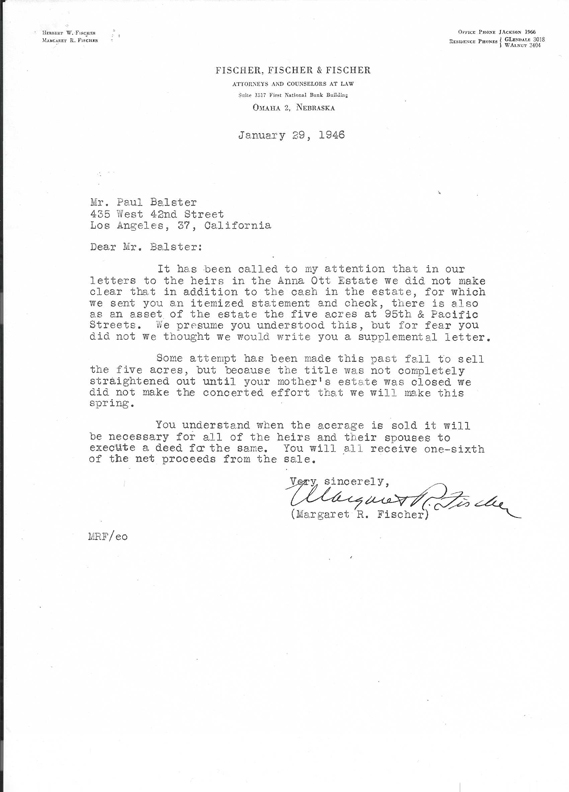
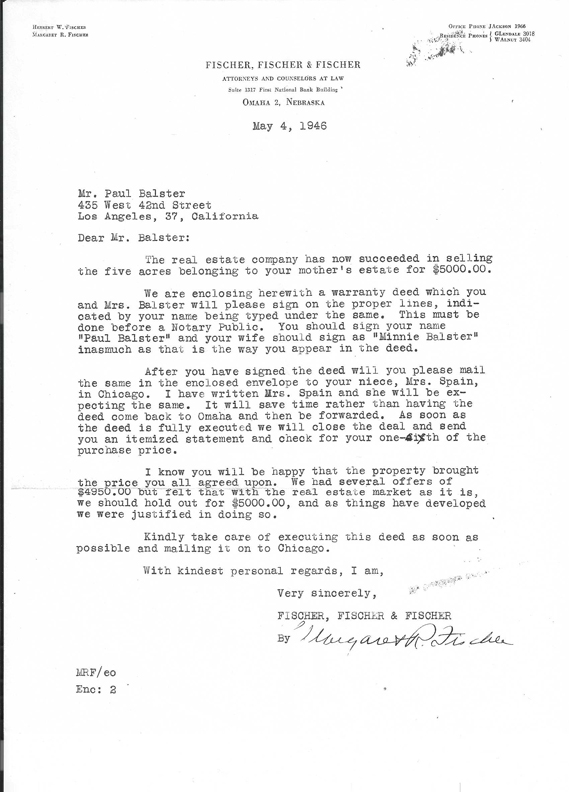
The letters of January 29, 1946 and May 4, 1946 are from the estate attorney’s office representing the Ott family. They regard the selling of the additional missing five acres from the family’s original plot. Woodie and I are united in the thought that this is most probably the land that Sunset Hills Baptist Church is now situated on. It was interesting to learn that the land was still held in the Ott-Balster name all of these years past their removal. Ultimately I did not find the land was sold to the Nebraska Baptist State Convention, leadership of the later Sunset Hills church, until 1959. We will get to those particulars in a bit. By aerial photographs, it would appear this five acre parcel remained rural land in the meantime.
From Woodie with permission: “Miss Cassette, I have located two additional documents regarding the 9402 Pacific property and Anna Ott. Both are letters from attorneys at the time. I would suspect they have some detail that will be of interest to you. They are about settling the estate of Anna Ott and to Mr. Paul Balster, her son. I also found a will prepared by Anna, but it does not add any details about the property or home. What I am sending to you has information about five acres of land at 95th and Pacific. This does not appear to be the 96th and Pacific 5 acres. You must have more detail, but to me it seems as if it could be 5 acres that now has the church on it.” I Thank You, Woodie Arp!
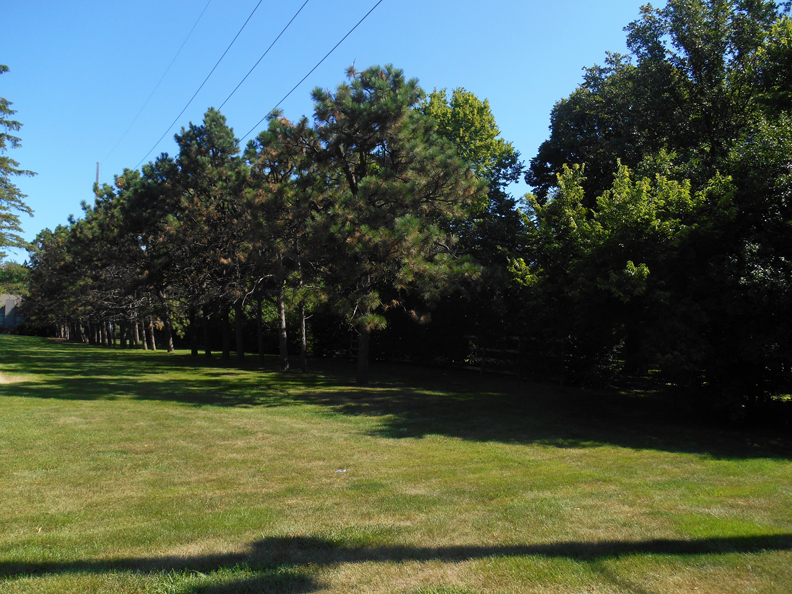
The beautiful church property as seen in 2020. This row of trees is to the west of the 9402 Pacific parcel line.
Night, Neighbors and the Country
As examined in our epic Hidden House investigation, it was during the 1947-1948 time period that internationally renowned Omaha businessman, local county commissioner, real estate developer, multimillionaire, sometime playboy and monkey fancier, Carl Willard Renstrom moved to the West Pacific area (10001 Pacific Street) with wife Catherine Gannon and daughter Vera. It is assumed that cozying with rural folk spurred the solder and curler tycoon to become interested in county government. All of Omaha could watch as the Renstroms’ enviable equestrian lifestyle took roots along Pacific Street. The vestiges of the Renstrom estate and horse farm were seen until I left town for college and probably after. I still look back along the southern creek edge, as if I’ll see the fragments of a white painted wood corral fence.
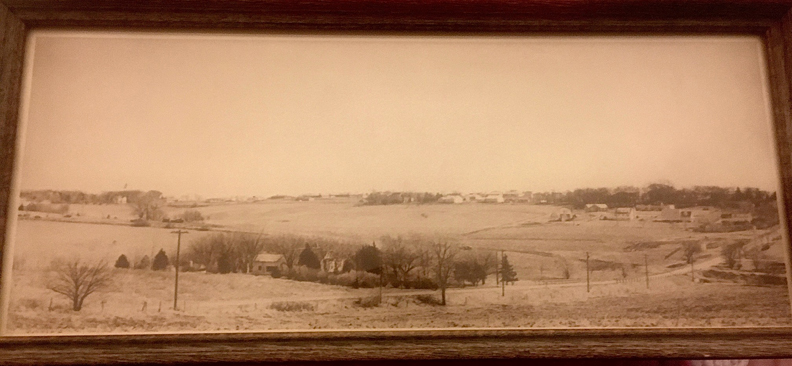
Kevin Tierney’s framed photo, from his father’s collection.
Back in March of 2021, I received a message from a favorite My Omaha Obsession sleuth, Kevin Tierney. Kevin included a historic photograph of 9402 Pacific Street that I surmise to be from the late 1940s or thereabouts. To my eyes, the photographer is southwest of Pacific, facing a northeast angle. Across the way is the 9402 property and to the east are the new homes of South 91st Circle and further still 90th Street. Kevin wrote of the 9402 Pacific home and the image: “My father was a groomsman in a wedding in the house in the mid 1940s. We moved across the street in November of 1962. I recall the west field against the church property had a horse. Pacific was still two lanes and the house wasn’t as hidden. I only remember the house being white. The horse farm fence was always there in my memory. I’m not sure the year that photo was taken. I’m not even sure how my dad got it. It’s an old photograph though. I know you are the master of researching Omaha but a few of the houses along 91st Circle are there. I’d guess they are fairly new from the lack of landscaping. The flat roofed Spanish style house was my friend Sam Cooper’s home in the 60-70s. His dad was an attorney for the city or county. The house is slightly different now. They added a 3-room addition on the roof in the early 70s. Even though it’s drastically different, you can see the Dutch roofline and other touches that honor my memory of that green space and the beautiful old houses along 90th Street in my childhood.” No longer living in Omaha, Kevin believes, as do I that it is hard to watch and hear of mid-city icons and farm history being scraped away from Pacific Street.
Let’s get out our magnifying glasses at look at this incredible glimpse into old rural Pacific.
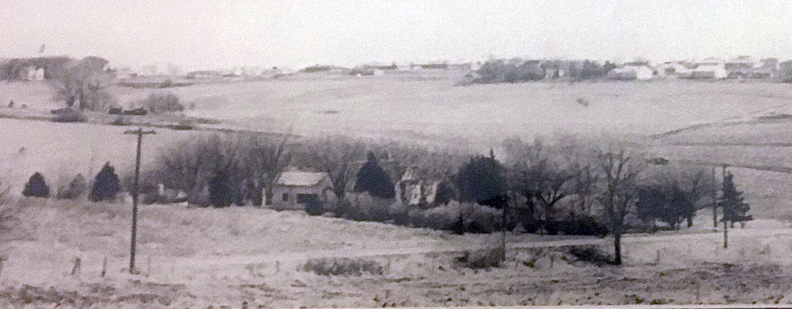
9402 Pacific enshrouded by trees. It looks like so many places one might heedlessly pass by out in the country.
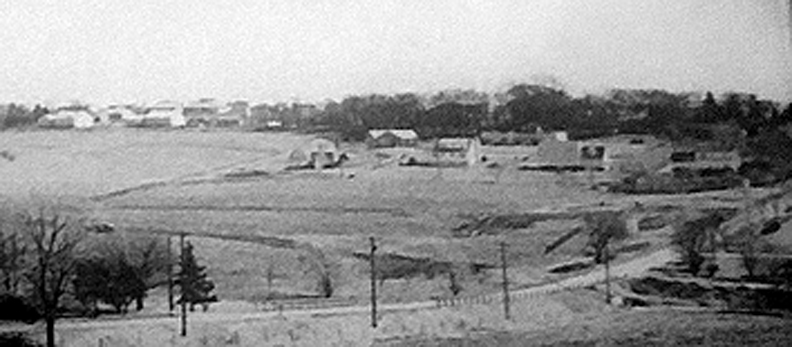
In this detail, we view the original South 91st Circle homes in the Balla Machree development as seen mid-hill to the east (right side of image.) The Balla Machree homes were primarily built from 1940-1958. I would guess this photo was taken in the mid 1940s, primarily because of what is not built yet. In the far distance are rural out buildings and the dark ridge trees appears to be South 90th Street. The Daniel Cary home in the 93rd and Pacific vicinity was where the Dana Van Dusens were pleasurably stranded during an unexpected blizzard in the 1940s.
As eccentric English neighbor Mr. Harry Bentley might have whispered, “It used to be like living in the country. But now…quite a built-up area.”

Farewell My Past
Starting in January of 1947, local newspapers circulated tales of a new Mrs. Roger Holman. Still considered a society woman, upholding her 9402 Pacific outpost, Helen had apparently taken up a paintbrush and was freeing herself. (Miss Cassette approves of these types of overhaul.) Helen had refashioned the Ott horse barn, in fact her own Chicken Inn, to a chic painters’ studio. The remodeled barn had stylish walls of painted soft gray and bright chintz curtains hung at the windows. It all sounded so wonderfully 1940s—my favorite. “Best of all, it boasts a perfect north light.” This perfect light is most likely what inspired Helen to begin her rigorous painting schedule from about 10 to 4:40 every day. Painting with oil, the article stated that “portraits are more than a hobby with her” and that Helen required about eight to nine sittings with her subjects to “catch a likeness.”

Example of 1940s chintz fabric for the uninitiated. I couldn’t refrain.
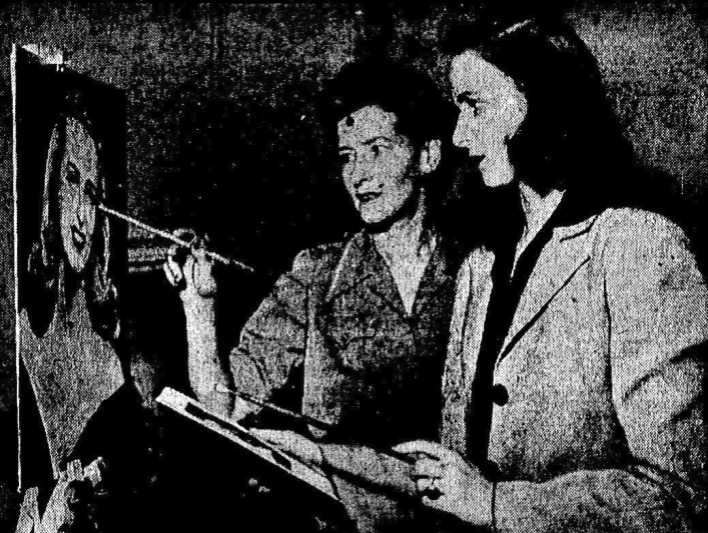
Image from the OWH. January 19, 1947. Complete in their edgiest 1940’s collars sans painting smocks, Mrs. Roger Holman and her daughter, Miss Sally Holman, painting together. “Almost any winter afternoon one can find Mrs. Roger Holman at work on a portrait in her cozy studio. And the chances are that her daughter, Miss Sally Holman, will be painting too. Mrs. Holman has always been more interested in portraits than in any other type of painting. She studied under J. Laurie Wallace.” The J. Laurie Wallace name and home studio are delicacies that come up time and time again in the office. We cannot wait for that investigation!
Enter Mr. Farquhar
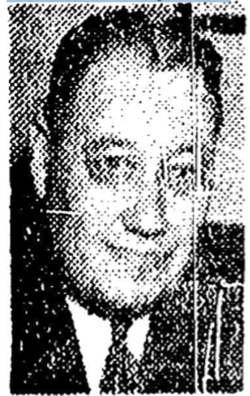
Raymond Revere Farquhar, as seen in the World-Herald in 1945.
I just knew it wouldn’t be long for the vivacious, painting Helen to find love again. That May of 1947 it was announced Mrs. Roger Holman and R. R. Farquhar were set to wed in August. I would discover R. R. stood for Raymond Revere Farquhar. Born in 1895, in Lincoln, Nebraska, “Ray” as he was called, had children Elizabeth and Burkett Farquhar with his wife, Josephine Sarah Burkett, who had died April 28, 1943.
Piqued Sidenote: Interestingly when Helen Holman and Ray Farquhar announced their intentions to wed, Mr. and Mrs. Frank Latenser and Mr. and Mrs. Frank Selby threw a picnic supper at the Latenser home for Helen. Of note Frank J. Latenser, architect, was son of John Latenser—one of the sons of the reputed John Latenser & Sons. Frank Selby was builder of the infamous trio of Frank Selby Apartments (830 South 37th Street, 3710 Marcy Street, 825 South 37th Avenue), designed by our heartthrob architect, Reinholdt F. Hennig. I only draw your attention to these architectural names because in the following Farquhar years, the once Ott farmhouse would grow into a stylish, eclectic home. Did Latenser or Selby have a hand in these additions?
1940s Food Lockers
Ray Farquhar had an interesting, pertinent career by the time Helen and he wed. Farquhar was secretary of the National Food Locker Manufacturers Association and executive director of the Frozen Food Locker Institute, a national organization. Frozen food, food lockers, and the construction and management of this public storage, unbeknownst to me, were a booming business in the 1940s. I knew about cold food storage warehouse building for various companies in downtown Omaha but I did not know anything about citizens having access to or need for food lockers.
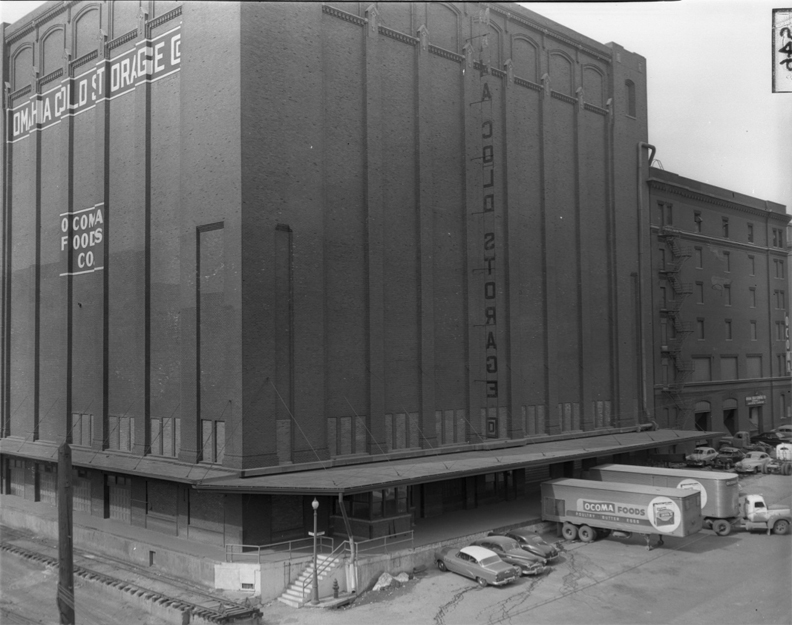
Example of the kind of warehouses I tripped across in previous investigations. The Ocoma cold food storage building. Located at 8th and Farnam Street. Creator: Savage, John (1903-1989). Publisher: The Durham Museum. Date: May of 1956.
I spoke with Mother and Stepfather of Miss Cassette and they assured me that in their hometown, people rented cold or frozen space in “lockers” in the 1940s, before most regular folks had freezers in their homes. It really wasn’t until the later 1950s, when domestic freezers became more affordable. Vegetables could be put into these storage units as would meat. My parents primarily described these rental meat lockers. If one was headed into town, one might swing by the meat locker to get their food out. The frozen food lockers of the 1940s, held in public storage, were all news to me and sounded wild! A family could pay a rental fee of about five dollars a month and were given a key to their unit or were keyed in by a locker operator.


A 1940s tutorial on packing your food “into special boxes” for storage.
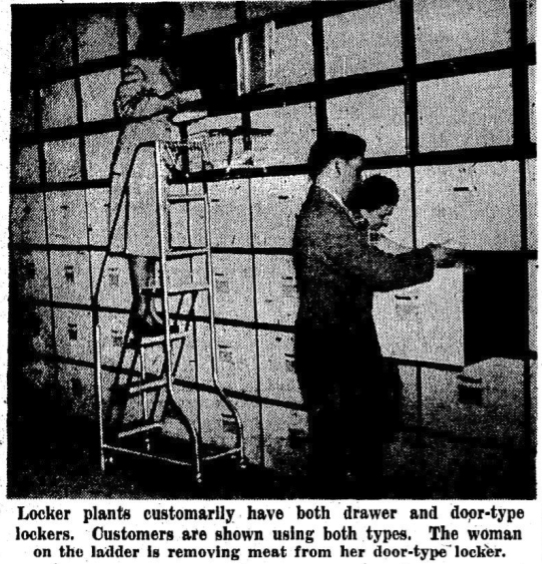
Image from OWH. 1947. No, Little John is not playing at the county morgue again. He’s at the family meat locker picking up tomorrow night’s meal like a good boy.
I found a quote from Ray Farquhar from this time period: “Nebraska has gained recognition as one of the greatest food processing and distribution centers. But its four hundred locker plants have made an equally enviable record in reducing food costs for more than half the homes in the state.” The article went on to say, “Food storage figures grew with the number of lockers. In 1943 there were 275 plants in Nebraska with an average of 350 lockers each.” Worth mentioning for the obsessives, the 1948 City Directory revealed that Ray and Helen Farquhar’s business labeled “Frozen Food Lockers” was located at 656 Insurance Building.
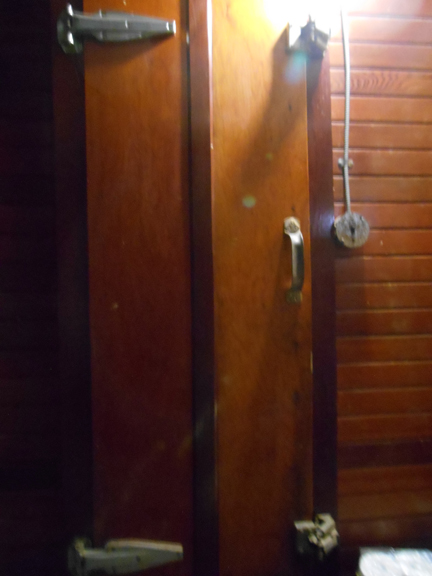
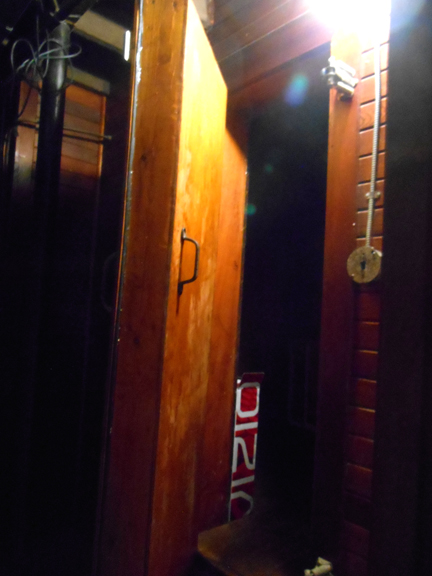
Photos from the Holman-Farquhar cold storage at 9402 Pacific Street. Paul Klein: “This freezer room is old. You could put a couple of whole cows in here.”
When I toured the Klein home at 9402 Pacific Street home in August of 2020, lo and behold, there was a walk in freezer from yesteryear in the basement. Earlier I had asked you to remember when the Holman clan moved into the Ott farmhouse, the newspapers noted that the Holmans were fresh-freezing their vegetables in their home freezer by 1943. Holman would have been up to speed in all things food, considering the field he was in. The walk in basement freezer I photographed was wonderful and large. I believe the door must have been five inches wide, if not more. I did not know of the connection to the Holmans or the Farquhars at the point. It looked very much like parts of my grandmother’s parents’ home basement, renovation dated to 1920-1940. I imagined it was original from the Holman years (or possibly earlier?) and was upgraded by Ray Farquhar. I would guess the latter, considering he was an expert in the field of the food freezer.
The Glass Key
Are you the one with the tired eyes, exhibiting such bravery into the wee hours of this mid-winter night? There is still much to be praised of this mysterious 9402 Pacific. In fact things really started to take off, in my view and I only wish I had more details to share. It would appear that Mr. and Mrs. Farquhar began to make some changes to the home and even in their conception of the ten-acre lot in the period of 1947-1955. I would find a number of advertisements that let on the couple were interested in paring down and selling off the large Ott parcel. It is undeniable that the rise of tract housing and expansive ranches that would spring up around them were a consequence of the rapid transformation that shook American society after World War II. The Farquhars no doubt could see the writing on the wall as Omaha moved west. And ten acres had to require a lot of energy for a family who was no longer interested in keeping up the gentleman farmer routine. These years were the salad days of society suppers, cocktail parties, breakfast brunches, garden suppers, picnic soirees, bar-b-ques, drinks at the Farquhars before the show etc. The horses were gone, as were the chickens. In 1951 I found a number of ads, this one from December. I thought it was originally for the church site but now I am of the belief it was for the eastern portion of their farm property. “For 2 or 3 ranch bungalows. 94th and Pacific Sts. 5 acres. Nearly 500 ft frontage on north side of Pacific Street. See this one today, $7,500 cash.” I only made the connection later when I saw a good chunk of the Holman-Farquhar land was severed from the parcel on the next warranty deed after sale. More on that in a bit.
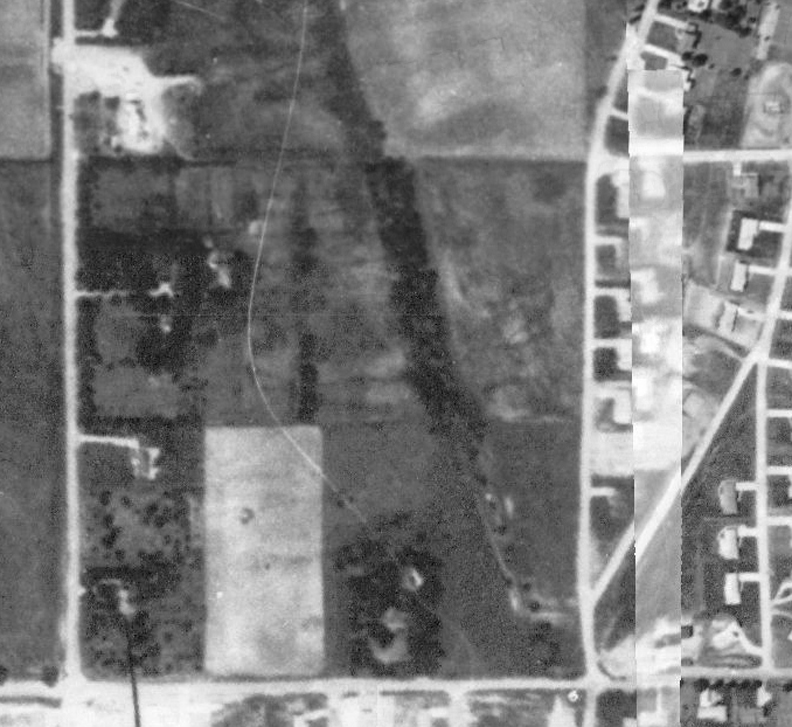
The 1955 aerial of the Farquhar land borrowed from the GIS site. Pacific runs east west at the bottom of the image. 93rd is seen vertical on the right and 96th Street is seen running north and south on the left hand side. It looks like the five acres that would later become Sunset Hills Baptist Church (to the west) was excavated or leveled off in some manner. But one can see that there was housing building in around the original farmstead along 93rd Street. To the east of the enshrouded 9402 Pacific, one can see the meandering creek I had spoken of earlier. And I am sorry for the quality of this image and the strangeness. 1955 was a poor year for these aerials.
Also in this time period, the Farquhar couple modernized a number of features in the old farmhouse, which although read as unusual for the times, would have been seen in a spirited manner of the smart set. Let’s first start with the barn. As we know, Helen, as a single woman, had transitioned at least one room of the barn into an artist’s studio previous to her second marriage. With husband, Ray, they would continue on their renovation, altering once horse stalls into garages—four, to be exact—an extravagance for the times but telling of their stature. In addition to the large artist’s studio, the 1904 barn featured an office and two bedrooms. By the time I saw it, it offered kitchens, bathrooms and a number of bedrooms.
When I had the good fortune to tour the Dr. Klein family home in August of 2020, Paul, the caretaker son described a number of the original characteristics of the barn in addition to a queer little building out back. The barn once boasted of heated horse stalls. There were also apparently horse troughs leading to a bucket in the ground or some rigged contraption of the sort. The Kleins renovated the barn again in 1976 and those historic elements were removed.
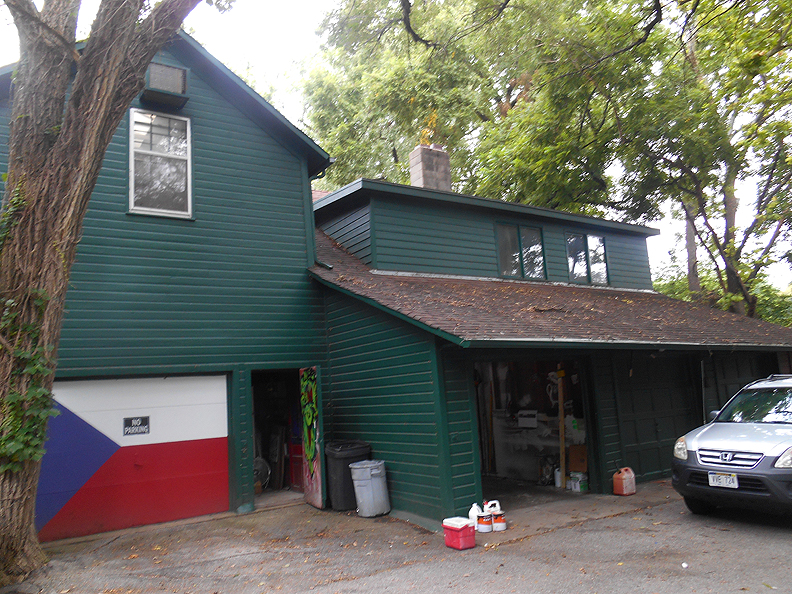
East side of the barn, with four garages. Addition made to the second floor on the north side.
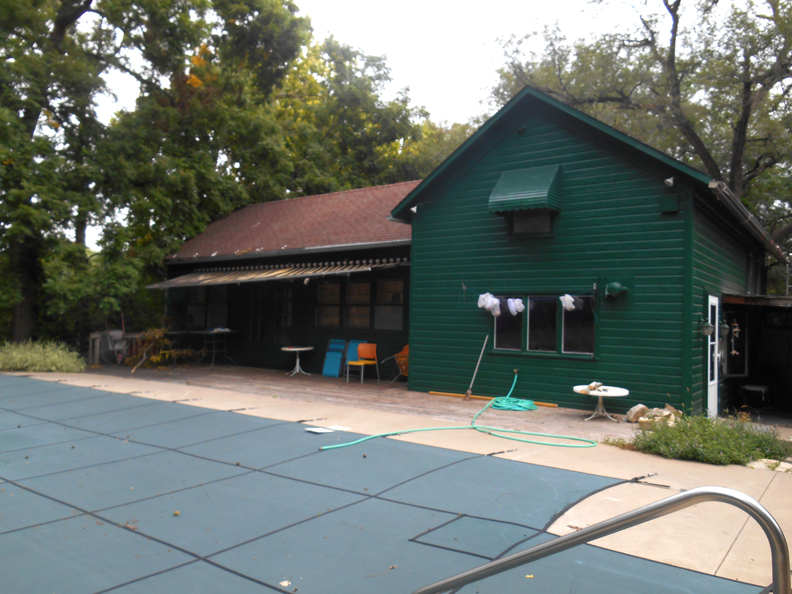
West side of barn served as a nice pool house-guest house when the Kleins added their pool.
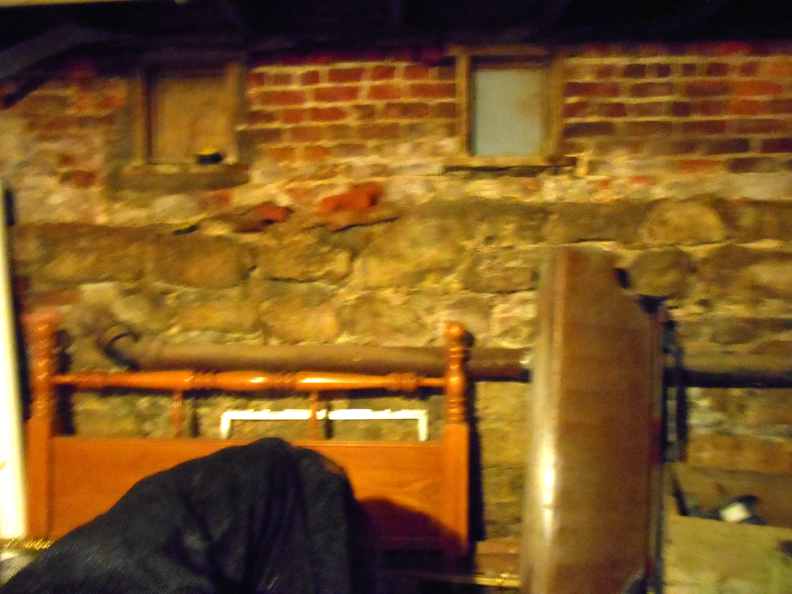
Once horse stall foundational wall.
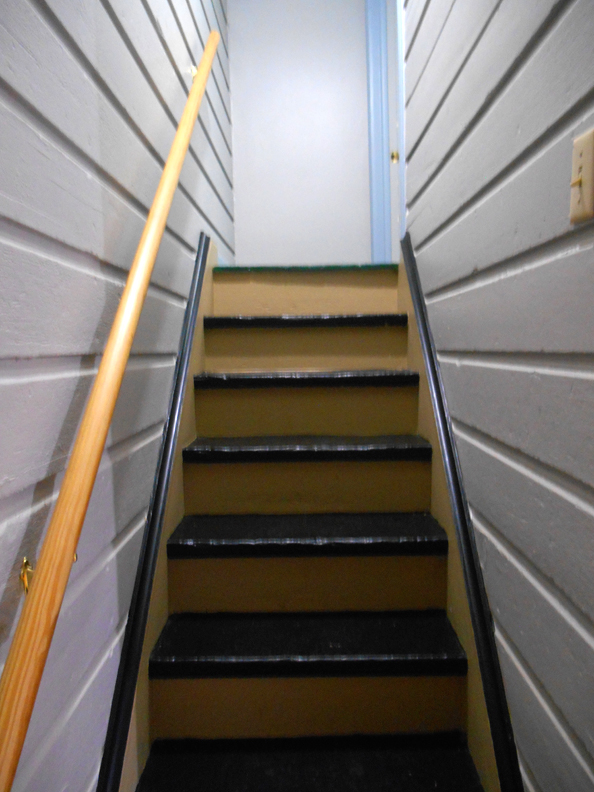

Barn interiors.
The little building out back was built into the slight hill to the west of the in-ground pool that the Kleins added in 1990. It was son Paul’s belief that the outbuilding was an original garage that once housed a Model T, which was hand cranked. He explained that the fireplace was not original to the 1904 time period but that the engine, vehicle or driver used a fireplace in that building. Someone smarter than I might have insight and be able to explain those particulars. My excitement was to find what I believe was the Farquhar picnic house. The site of many barbeque parties and outdoor gathers, the 1950s picnic house was a brilliant setup and one that should return.

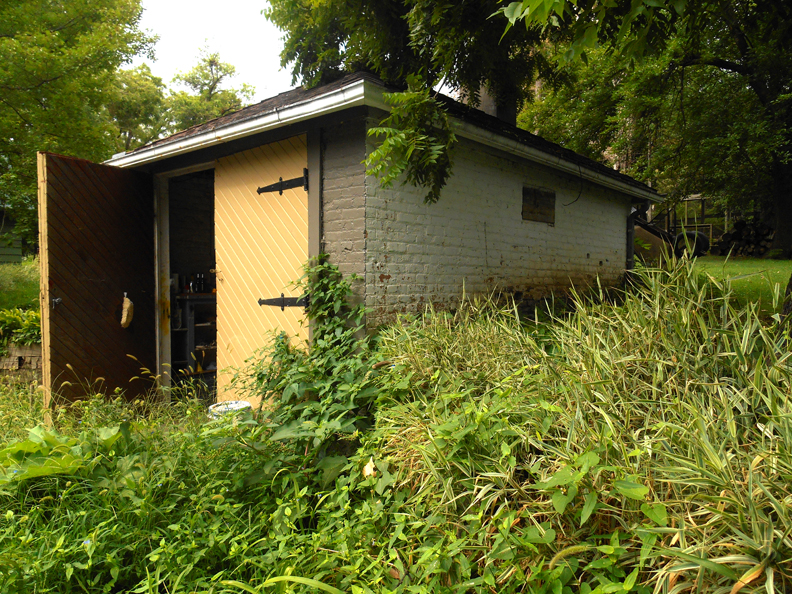
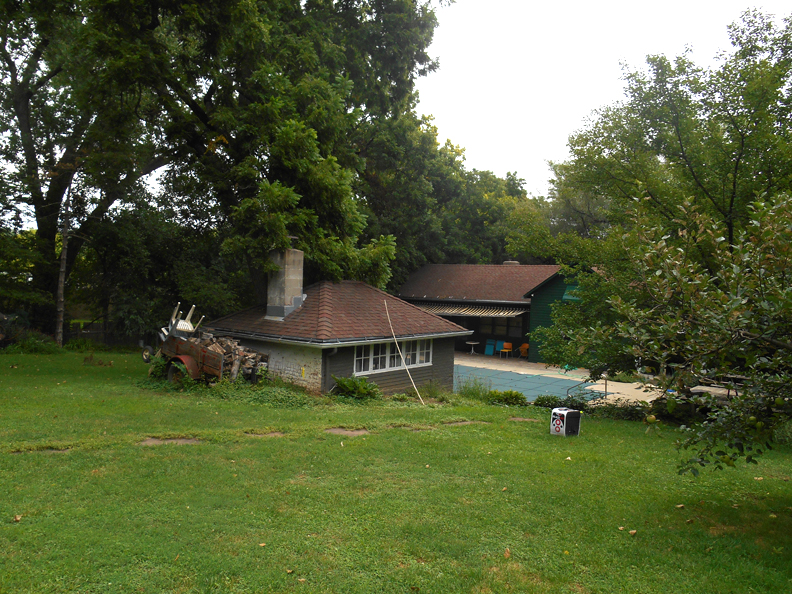
Rear view from the west of the little house built into the hill.
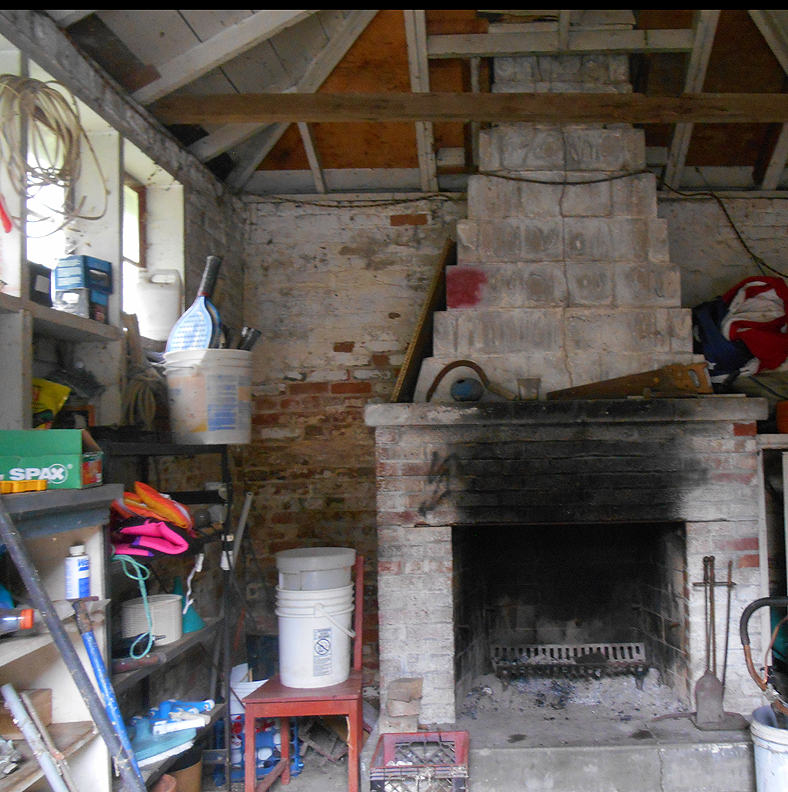
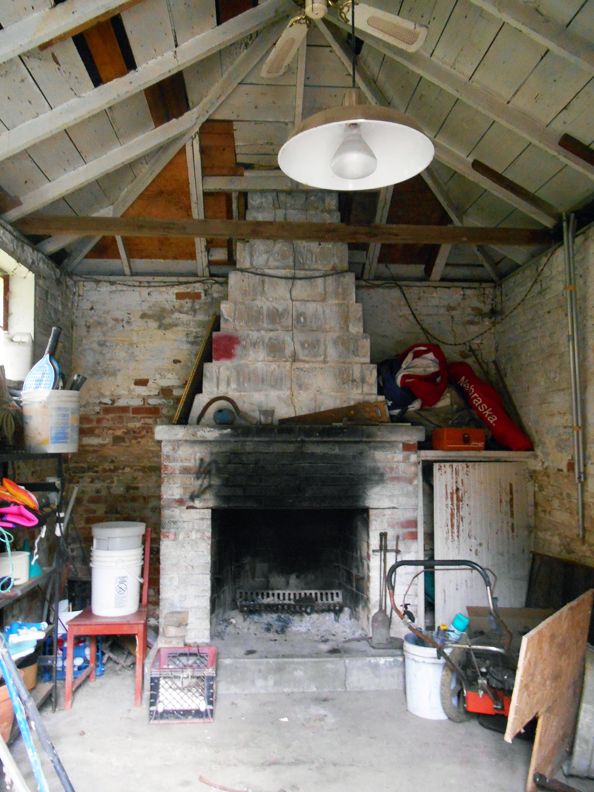
Large enough for a good size farm house table or chairs in a circle on a winter night.
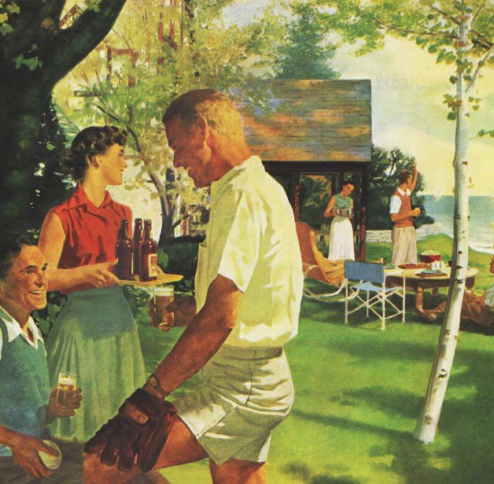
Illustration of the 1950s picnic house, a sign of suburbia or the leisure lifestyle.
The Farquhars added two tiled bathrooms adjoining two of the bedrooms, wood paneled rooms and an “L-shaped” all weather rear porch with built-in planters, very chic for the times, in brick with slate flooring. All perfectly MCM touches for their country house.

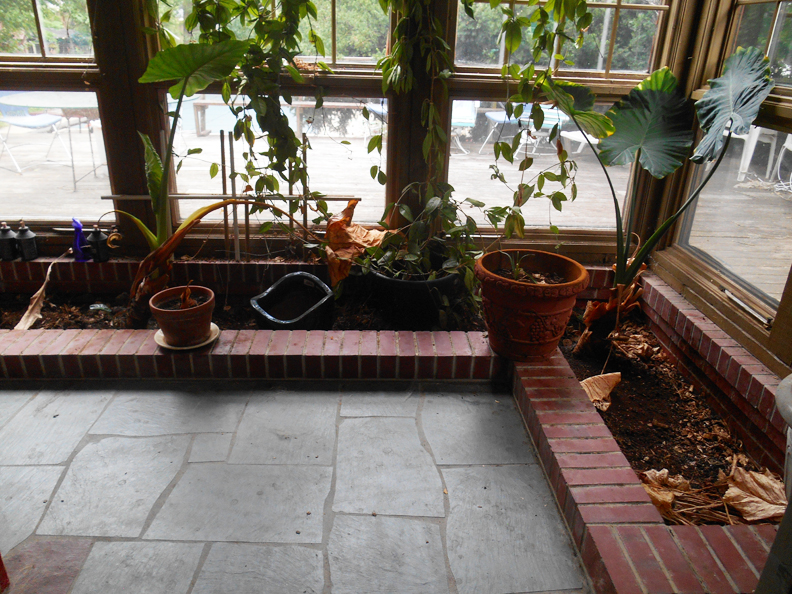
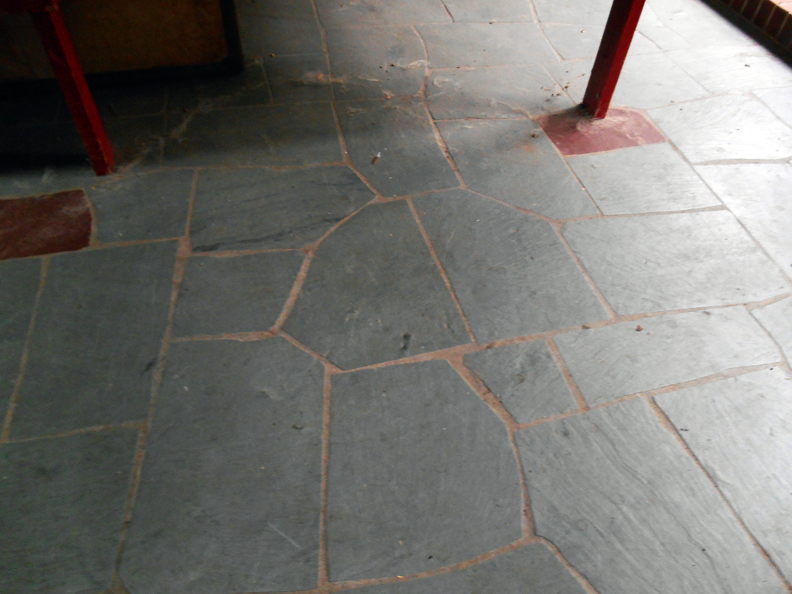
Remnants to the Farquhar past found on my August 2020 walkabout.
Although it would be hard to fathom the original Ott house without a fireplace, I am of the belief that the Holman-Farquhars added this more prominent MCM fireplace to the south side of the house, coinciding with renovation to the east side of the home. Its style screams the 1950s. This fireplace has a corner appeal in a large interior family room, which will be shared in our next installment. I have included Woodrow Arp’s photo of the original Ott farmhouse exterior for comparison.
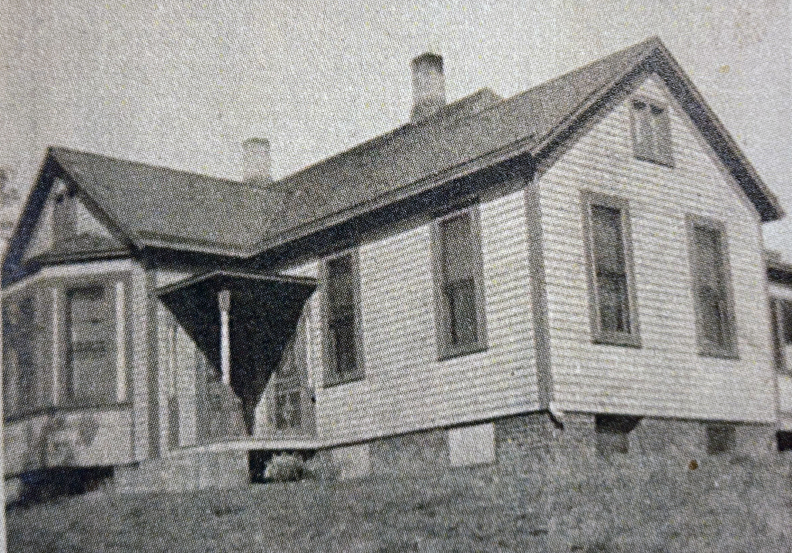
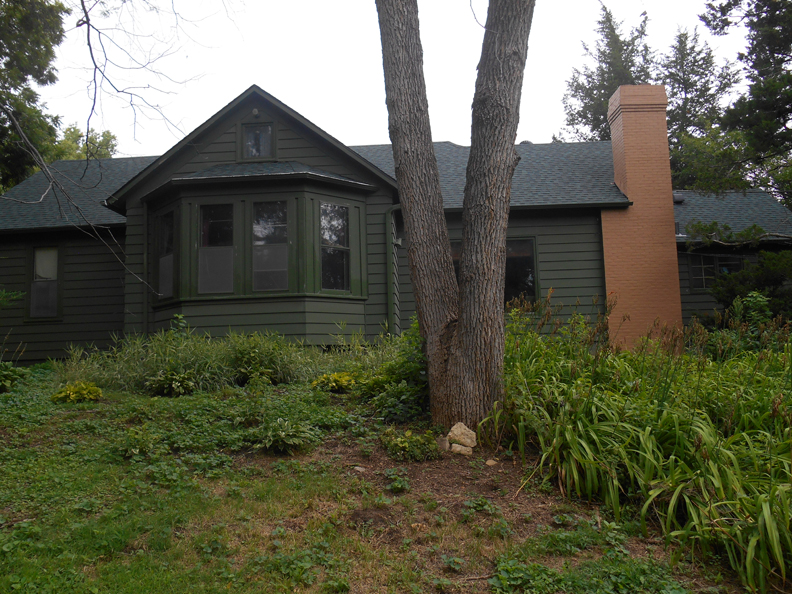
One can see the original Ott roof field. This hip plane essentially cuts into the Farquhar’s chimney. There is another roofing plane or field that is a bit lower “behind” the chimney that supports a second gable on the eastern most side. There is an additional east wing, built by a later family, that offers a third gable. All of these gables are seen from the eastern driveway.
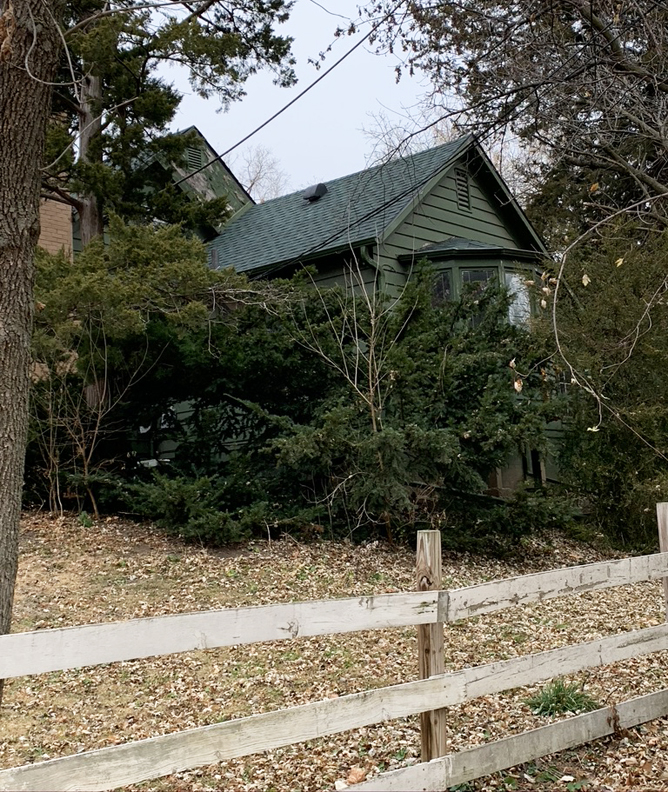
Three east gables.
Surprisingly in January of 1955, Ray and Helen Farquhar listed their 9402 Pacific property. “Charm of the past, but as modern as tomorrow, may be had with two or more acres if desired.”

OWH. January of 1955. “In the Path of Development”—no truer words. Later advertisements proclaimed 9402 a “Country Estate” and “Future Profits,” with regard to proximity to West Omaha and the ability to divide and sell off the parcel for more money.
On May 31, 1955 a new warranty deed was drawn up that stated: “Helen L. Farquhar, formerly Helen L. Holman and Raymond R. Farquhar, her husband” sold Raymond A Dundis and Betty J. Dundis, husband and wife a portion of the E10 acres of the original Ott farm–“said tract of land containing 2.003 acres.” That is how it came to be 2.003 acres. The Dundises agreed to that size acreage and the rest was sold off. I thought at one point there might have been an agreement to buy “portions of” because I found another real estate transfer notice later.
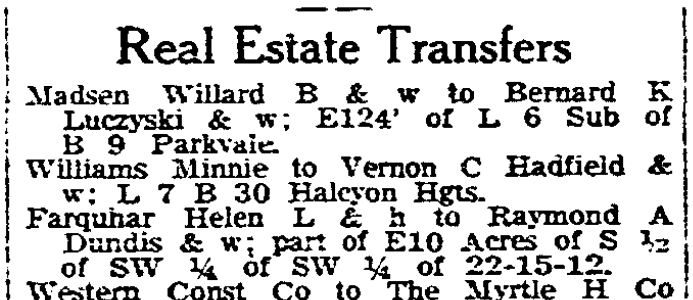
OWH. June of 1955 PHOTO real estate transfer.
The Farquhars moved to 3860 Harney Street, historically known as the Highland Court apartments in the Gold Coast neighborhood.
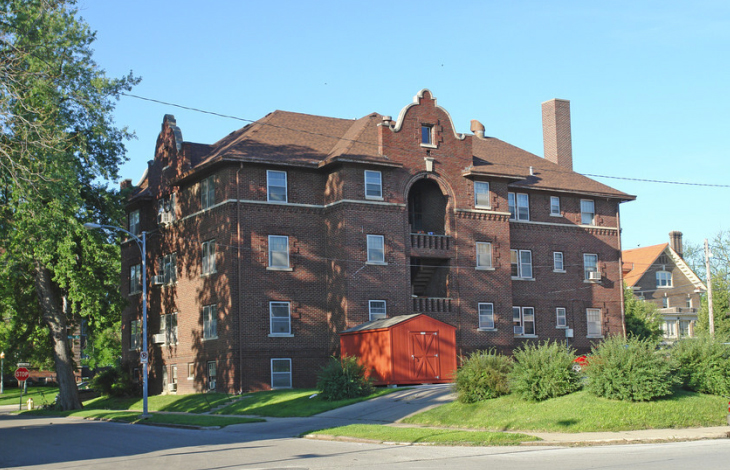
3860 Harney, as seen from Farnam Street to the north. These were lovely apartments, well appointed but certainly not hoighty toighty for the times. I wondered if the couple was staying there until they found their next home.
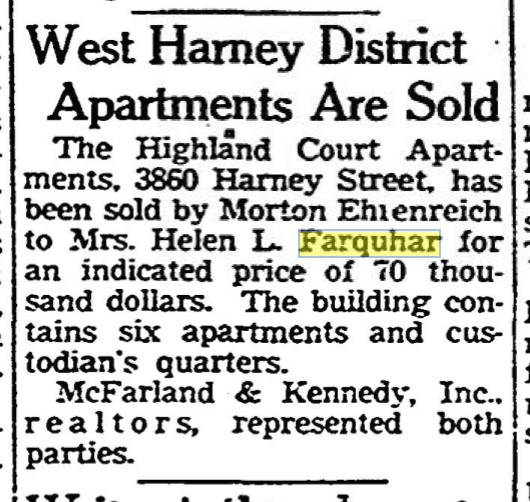
OWH. December 31, 1954. This just in. The Farquhars bought the Highland Court Apartment building and lived there. This was not a temporary abode. This is one of my life dream scenarios—almost up there with living in a hotel.
Raymond Farquhar died on January 28, 1956, at the age of 60. It was shocking to me, as he was so young and the couple had just transitioned. I know next to nothing of the situation.
For her part, our Helen Farquhar began showing her artwork in the 1960s. One of Omaha’s libraries hosted her first show. The next year she shared a small group show with Bill Farmer and Tom Bartek. I’ve got to think that she continued to reinvent herself and create her paintings. In 1985 Helen Farquhar celebrated her 90th birthday party in the divine Sans Souci room at (the Gloria) Swanson Towers, where she lived. (For more on the Swanson Towers, check out my investigation: I Want to Live in the Swanson Towers.) Daughter Sally and son David came to town along with grandchildren on both the Farquhar and Holman sides. It warmed my heart.
Well Fellow Obsessives, I think it’s about time that we sign off for the night. Please join us again for Part Three as rural 9402 Pacific further entertains the country club set, finds her eclectic disposition, and upholds her utopian, organic tradition, lives as a virtual recluse, all the while surrounded by a changing culture.
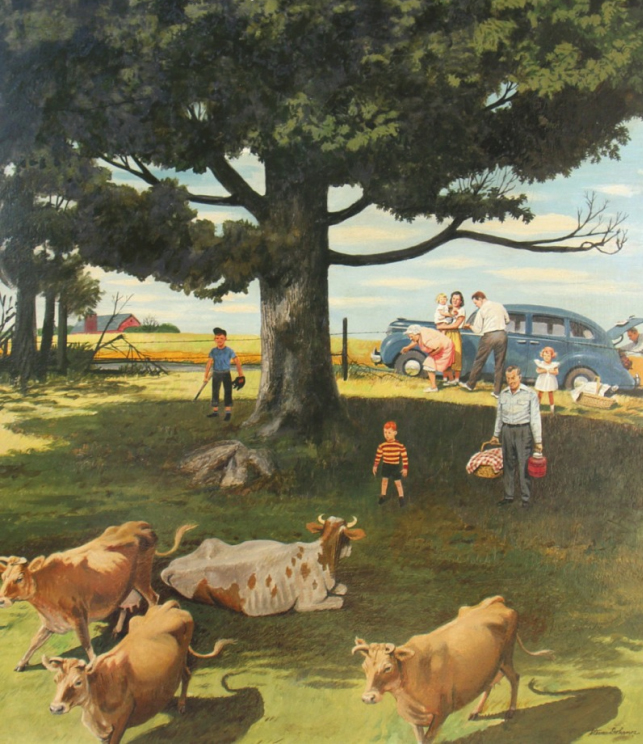
I think Stevan Dohanos’ 1950 Saturday Evening Post cover, Shoo the Moos, illuminates the Westward Moving Omaha Obsession of the 1950s—as the notion of suburbia gained traction across the States.
The strangely beautiful 9402 Pacific–a hidden history waiting to be told! I can only hope that some of my love for 9402 Pacific and its people has been transmitted to these pages. We are not done with them yet. In fact when we meet again, we will pick up with the Dundis family. I am confining myself strictly to these upcoming families and the plight of 9402 Pacific Street and just a wee bit of wandering around. We are guaranteed to come up with an ending, of sorts, this winter. However as you and I know, sleuth-to-sleuth, there is never really an ending. Please take care.
The fun never stops. This investigation now has a Part Three. Follow here: Mysteries of Omaha: 9402 Pacific Street Part Three.
I welcome your feedback and contributions to this 9402 Pacific Street investigation. I want to hear about 9402 Pacific and its history of owners, but please recognize that we have only crept up to 1956. There is much more to come. Feel free to share thoughts and clues in “Comments.” If any family members have photos to share, please email me so I can include these in the article. I am asking you to share this article on social media, through email or texts to friends, as I no longer have any social media accounts.
I invite you to poke around with your flashlight. Investigate. Hide in the shrubbery. Look under these rocks and down those alleyways. I am more than pleased to have you tiptoe about. By the time you head for home, I hope you have been fully Sherlocked and Satiated. Thank you, detective friends.
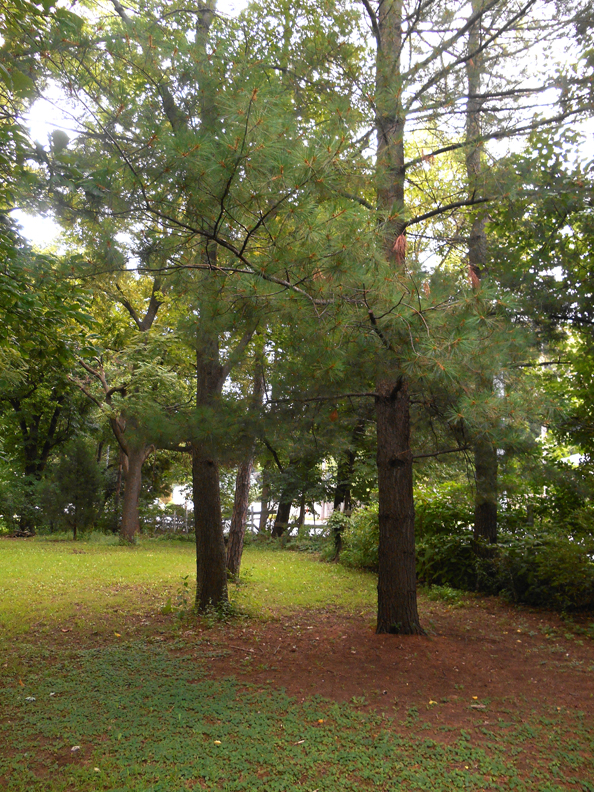
If you like what you see, you can keep up with my latest investigations by joining my email group. Click on “Contact” then look for “Sign me up for the Newsletter!” Enter your email address. It will then display “Thank you, your sign-up request was successful!” Make sure to check your email address to confirm. You will get sent email updates every time I have written a new article.
© Miss Cassette and myomahaobsession, 2023. Unauthorized use and/or duplication of this material without express and written permission from this site’s author and/or owner is strictly prohibited. Excerpts and links may be used, provided that full and clear credit is given to Miss Cassette and myomahaobsession with appropriate and specific direction to the original content.
If you are looking for more architectural and Omaha history sleuthing fun, ask your local or big box bookseller for my new book: My Omaha Obsession: Searching for the City. You can also order it through this website. Thank you.

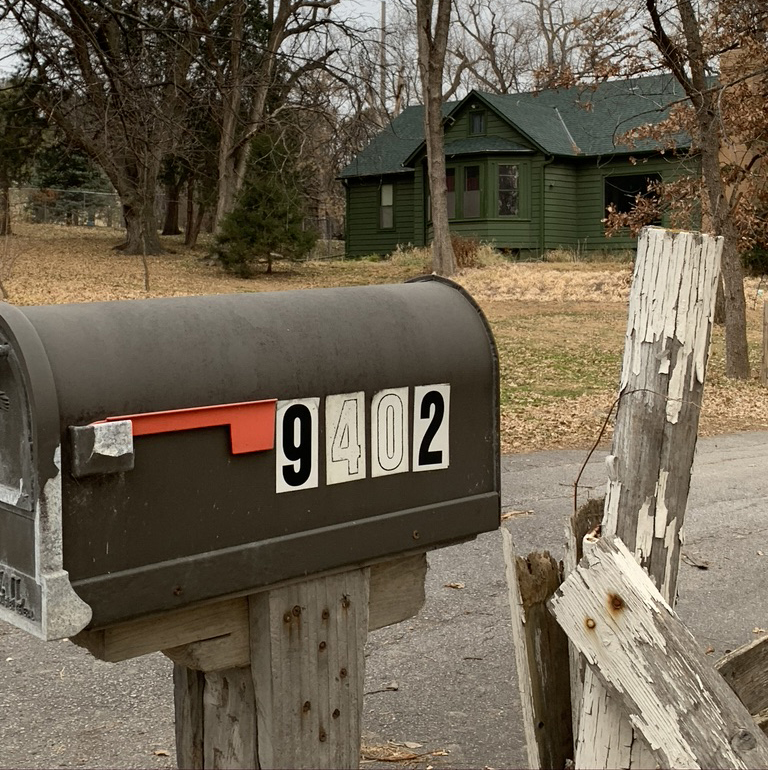
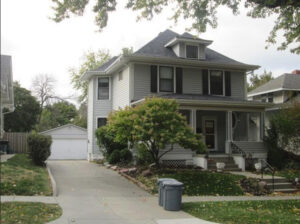
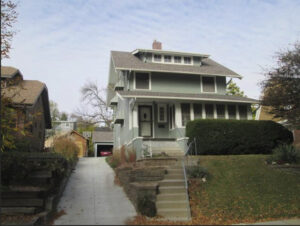
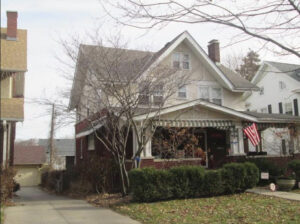
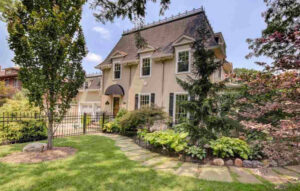
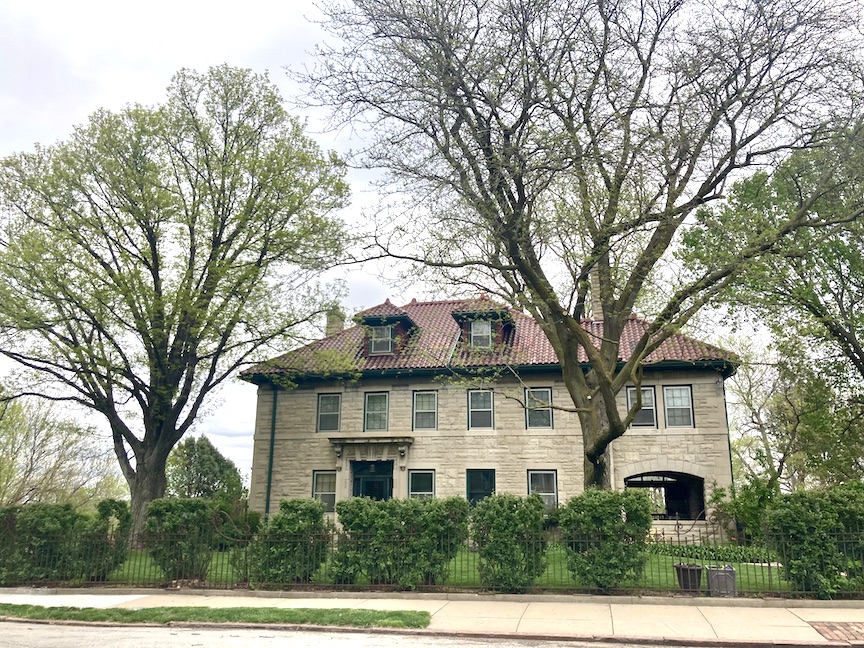
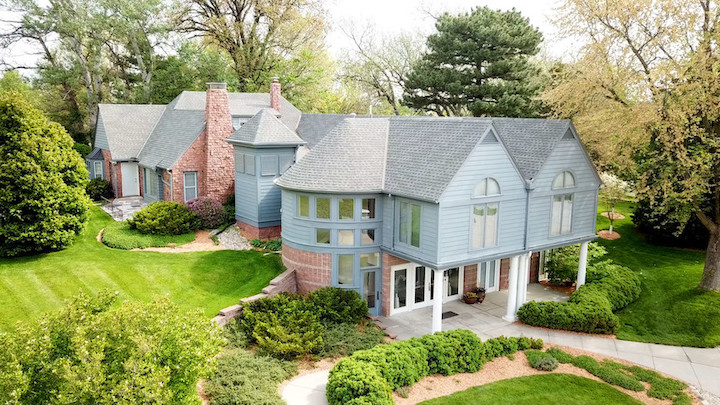
It’s so disappointing that Omaha is going to make cookie-cutter ugly row houses out of this fabulous property. New construction in this city seems to lack imagination. The new homes by Westside are hideous.
Interesting! Grew up at 91st and Frances since 1960. Curious about the homes before then!
I thoroughly enjoyed part II of 9402 w Pacific, especially since the Holmans were good friends of my family from the 20’s. My father worked at P and G along with Roger in the late 20’s and early 30’s, and I remember picnics with the family about that time.
Sally Holman was a good friend and I occasionally saw her on my visits home after they had moved to the farm house.
As you know, there were only a few homes in the area when we moved out there in 1935, with the farm house down in the valley west of us and Gene Milady’s new home soon to be a neighbor to the north. I am sure others were ahead of us, but my parents were heavy into food gardening and raising chickens, ducks, pheasants, peacocks and even a pig and a goat by the summer of 1936. Lots of eggs, which would come in handy today.
And your picture of a snowy landscape for school buses was right on. There were days it was a question if we were getting to Loveland school a mile away, and later to Central High, but I don’t recall actually missing a day.
Thanks again for the memories, and keep sleuthing.
Ed Busch jr
I have passed this place many, many times since my move to the Midwest and always loved this house. I never dreamed it was not only deserted, but condemned. The surrounding property with all the trees has always struck me as very peaceful and calming, and I often fantasized about living in that house. Such a shame when Progress demands the eradication of stately old places in favor of new crackerboxes that all look the same. I wish this place could be rescued.
I am obsessed with your blog. I have never been to Omaha and have no connection to the city but I just happen to run across it in 2018 when I I was home for 7 months recovering from surgery. As we waited for part 2 I went back and re read every past episode . My favourite area is district 66 with special love of the area around Christ the King. I love mansions and MCM. Sometimes I dream I am driving down Pacific and wondering which side street to explore.
All on my own I discover an interesting neighborhood called Wyman Heights It is far from your usual jaunts but it is curious. I love the mixture of housing. It reminds me of Pittsburgh with the rolling hills and view of the river. Any chance you may have a house to write about it that area ? I have been doing some research into the history of the development
hard to say which house is my fav of all the ones you have written about but I am really looking forward to a good read abou the Carey house at 600 South93rd. How I love the original picture you posted.
I live in Canada but I cant get enough of Omaha. Thanks again.
Hello Crystal,
You have warmed my heart! Thank you so much for the good cheer from O Canada! Isn’t the Internet remarkable? We might never have met. Crystal, I am obsessed with Wyman Heights and love that part of town. I have been in a number of the homes on a special tour years ago. I would’ve loved to of written about the area, but I try to research and create original contact. Unfortunately, or fortunately, however you look at it, a number of folks have already dug into this area. If you do a Google search, you will find their writing, if you haven’t already. Also, there is a historian who writes the North Omaha blog, and I try not to cross over into his territory out of respect. Omaha is a very small town and I try not to duplicate out of courtesy but also because the digging is the fun for me!
Thank you for writing in, and it would sure be great to hear that you come to Omaha someday. Miss Cassette
Hello,
I was looking for a source who might be interested in my mom’s Central High School scrapbook today when I came across your Mysteries of Omaha series, and I am still taking it all in. I do know the Holman history. Helen Holman was my beloved Gramma, and Sally my sweet Mom. So surprising to see my family featured in your chronicles. On my desk I keep the box Gramma gave to Roger for their wedding (Feb 1916) , and his letter to her just a few days before they wed. To see this all now is particularly poignant.
Best regards.
Hello Lindsey, Oh my! That made my eyes well up. Thank you so much for writing in. If there is anything additional that you want to share or any corrections that I can make, I would be glad to. Of course, I never knew your family but following them all this time made me feel something of an imagined connection. I do appreciate you sharing the detail of your grandparent’s wedding box and letter. I feel so rich this evening! Take care, Miss Cassette
Another wonderful story. Another sad day when they torn down such a historical and beautiful house, Looking forward to part three